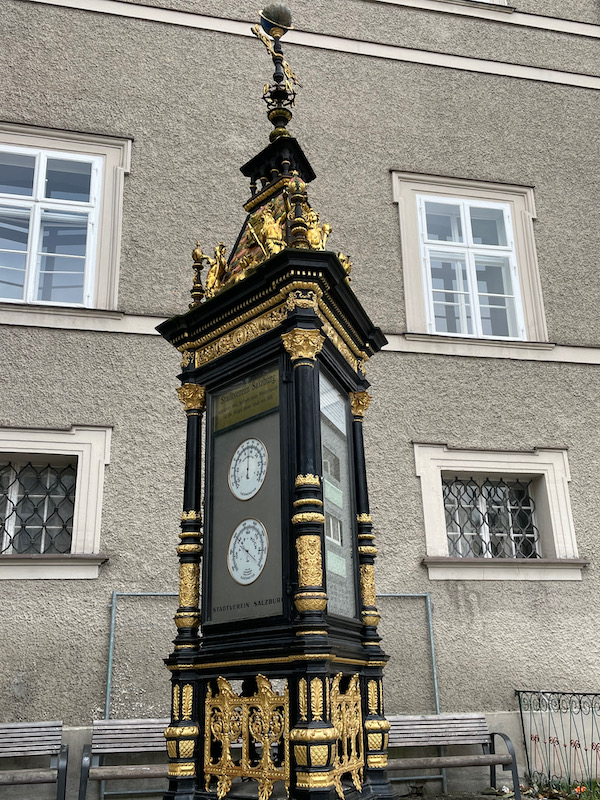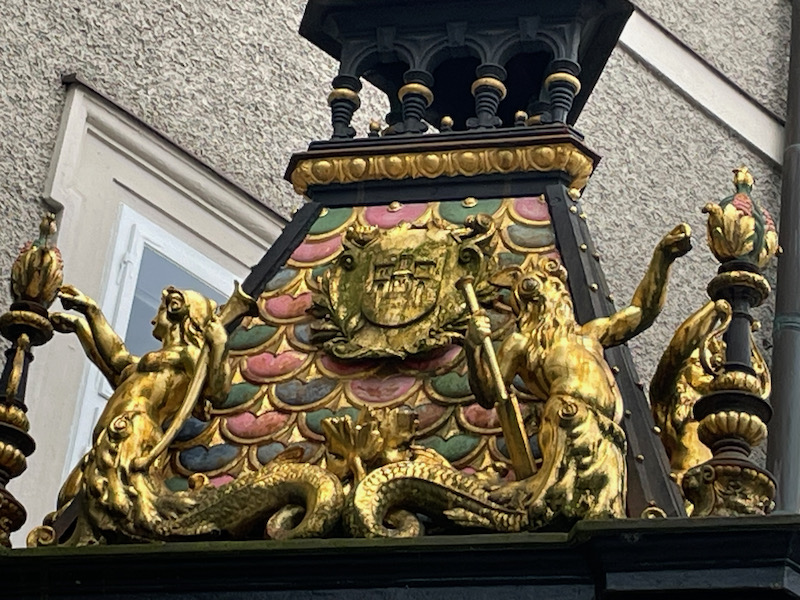Our Blog - Salzburg, Austria - Part 3
And now, we finish up the long weekend trip to Salzburg.
Hopefully you aren't tired of churches, yet! We start this page with the Franziskaner Kirche, which is one of the oldest churches in the cities and dates back to the 8th century. A new church was built in the 12th century but then destroyed by a fire in the 13th century. This building largely dates from around 1408 when it was rebuilt. The church is connected to the Franciscan monastery via an old connecting corridor across Franziskanergasse. The west facade, seen here, is pretty un-church-like :-) The 2nd picture is from a side road and this side looks much more like a church. A slender Gothic tower was added between 1468 and 1498.
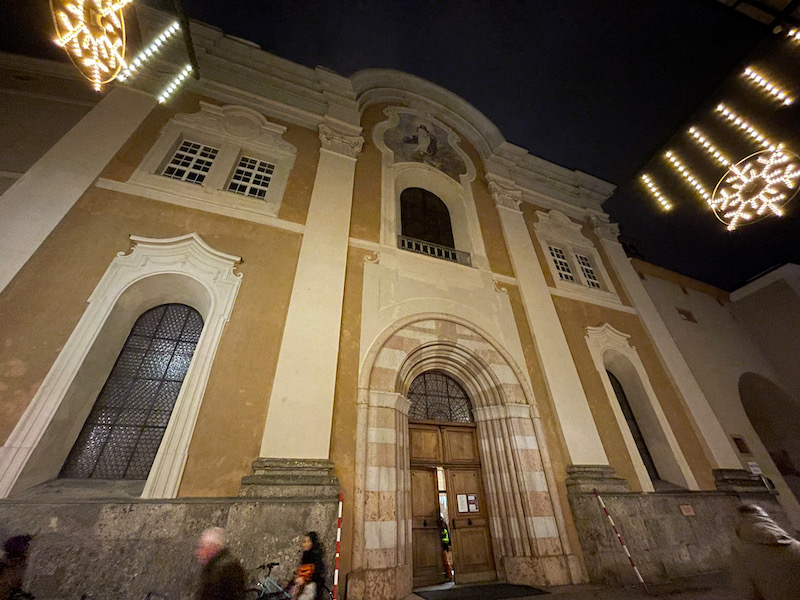
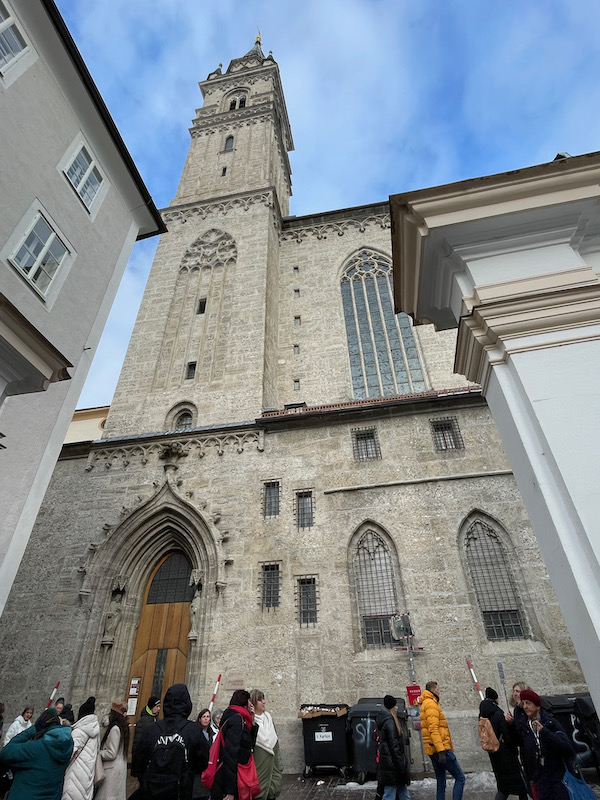
Here you can see the 2-story Gothic choir with the star ribbed vault, with the walls that seem unfinished. This is an interesting contrast to the ground floor, which has highly-decorated Romanesque chapels.
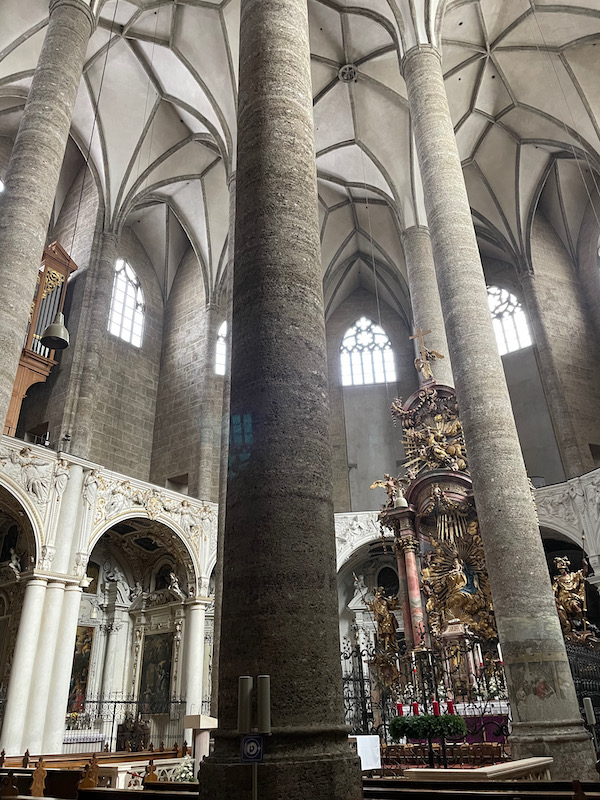
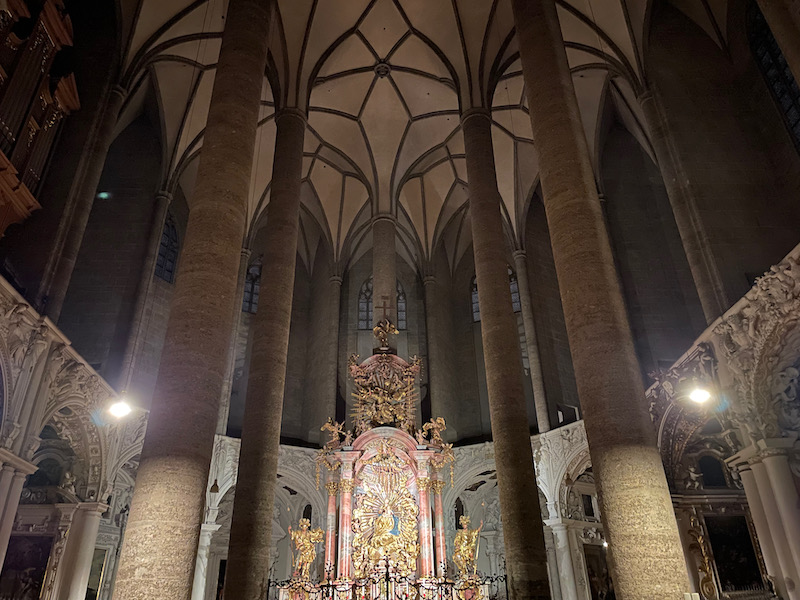
Created between 1495 and 1498, the baroque high altar has a concave wall structure and is bordered by double columns. The Madonna has a heartfelt facial expression, long blonde locks of hair, and a folded blue coat. The baby Jesus was added in the 19th century. You can also see the filigree Rococo grill which surrounds the high altar, added in 1790. The large statue on the right shows Michael the archangel slaying the dragon.
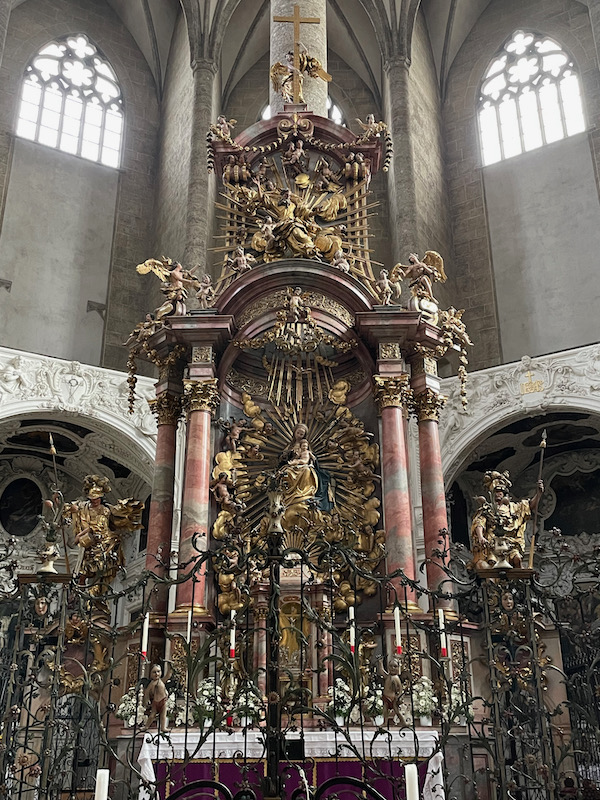
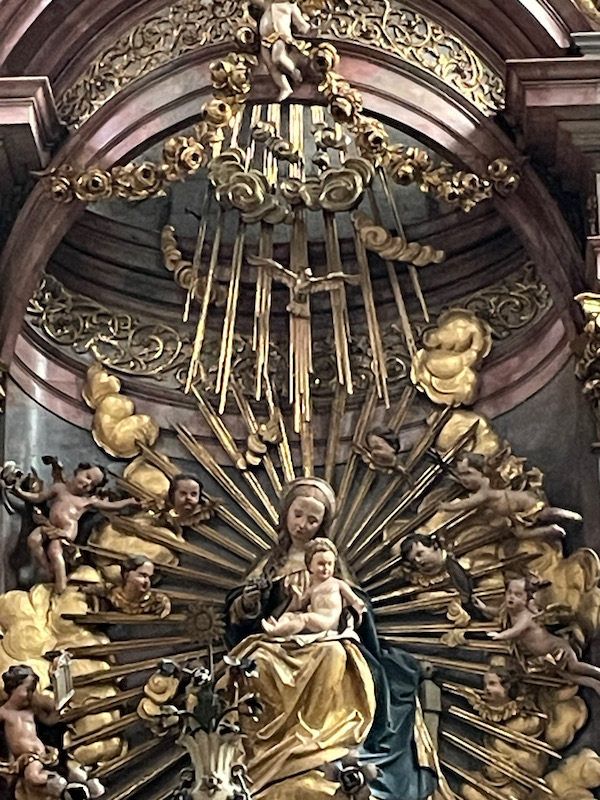
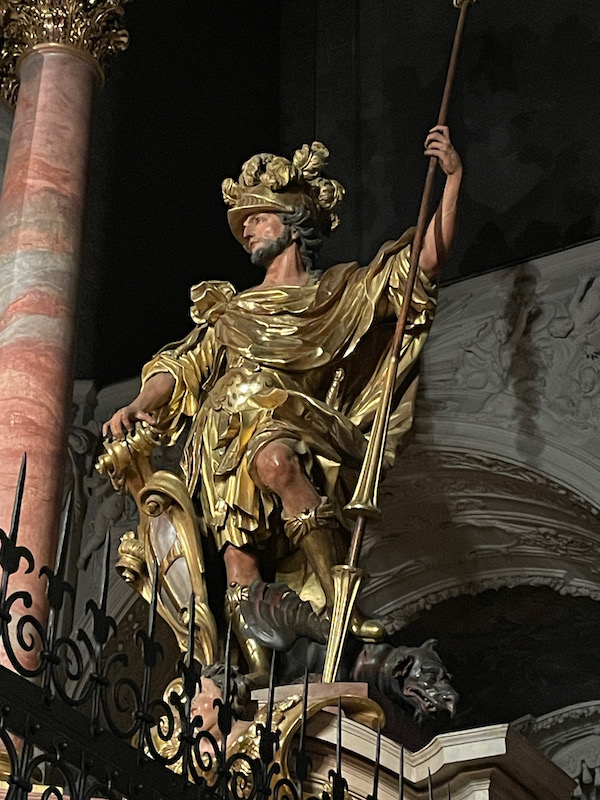
And speaking of the Romanesque chapels ... all around the high altar are chapels that date from the 1600's. They are all richly decorated and all very different.
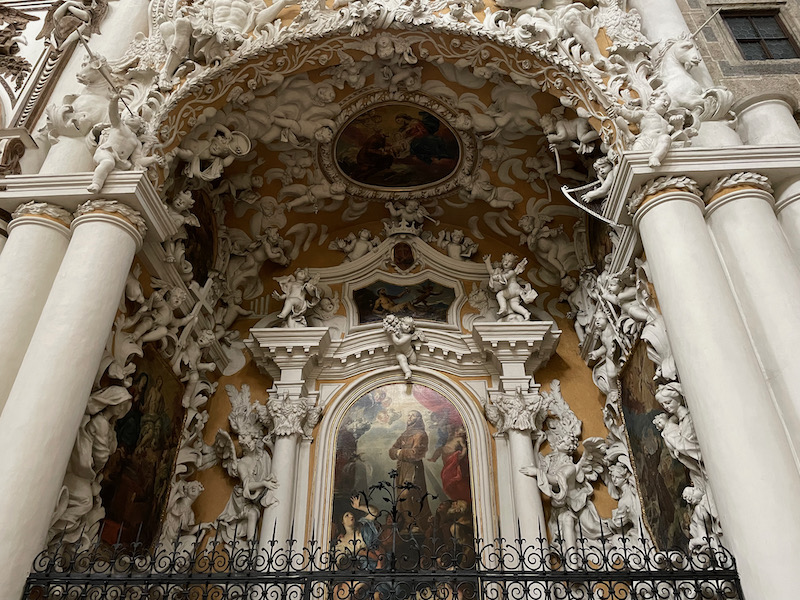
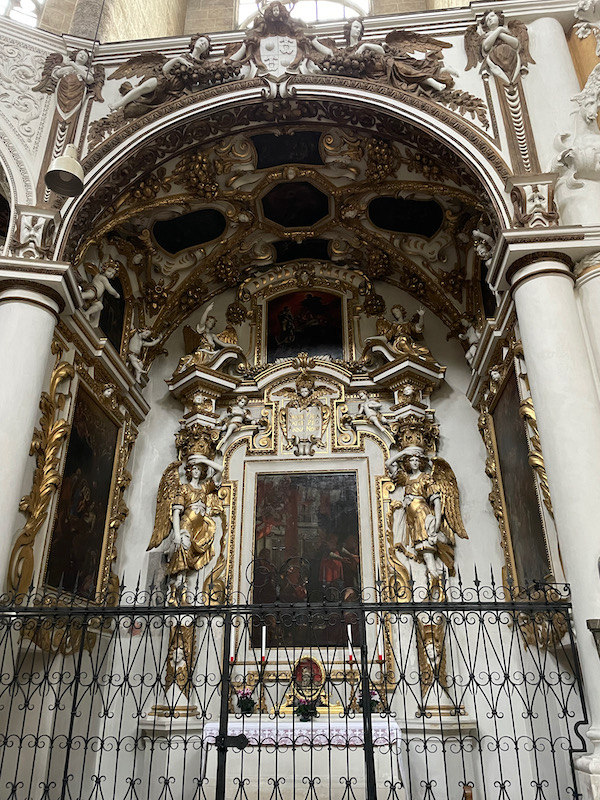
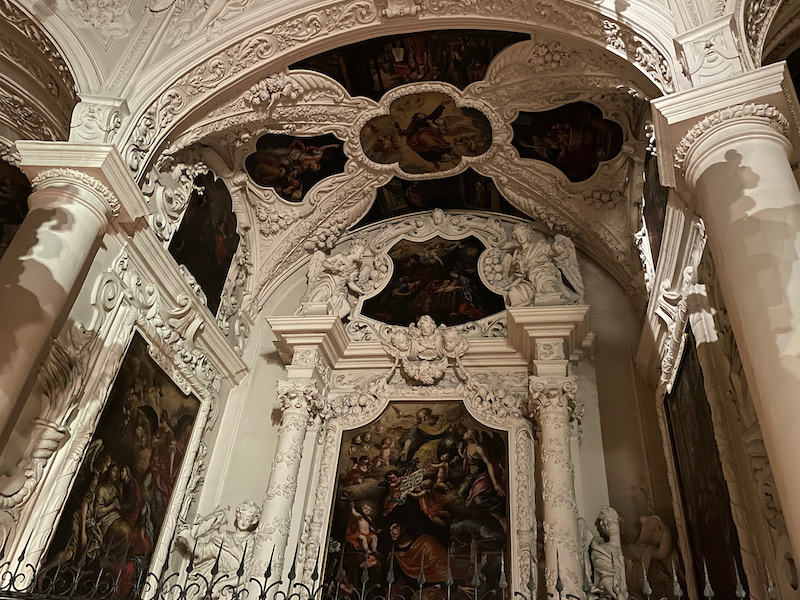
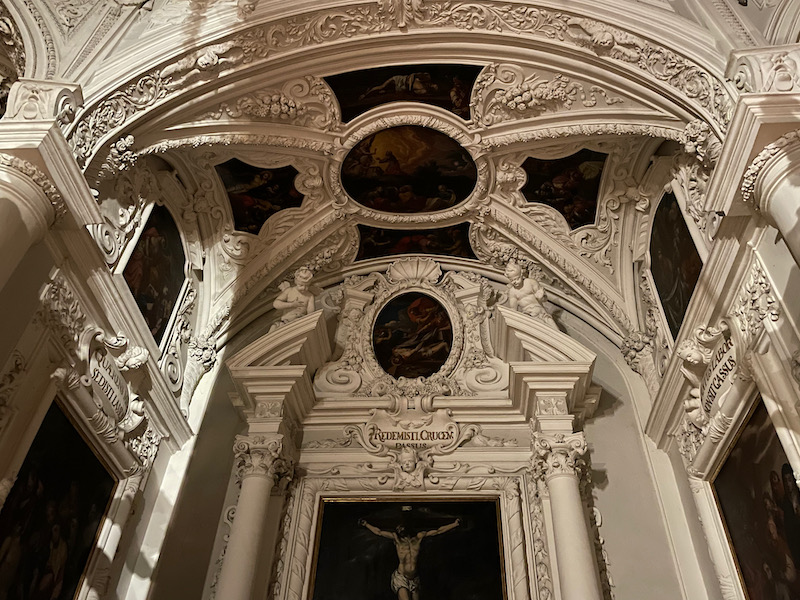
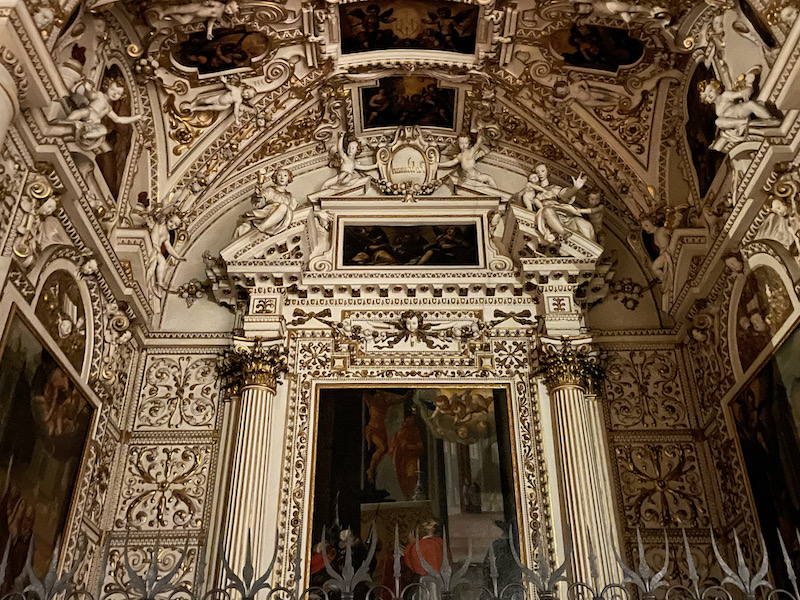
At the base of the pulpit staircase is a marble lion from the 12th century.
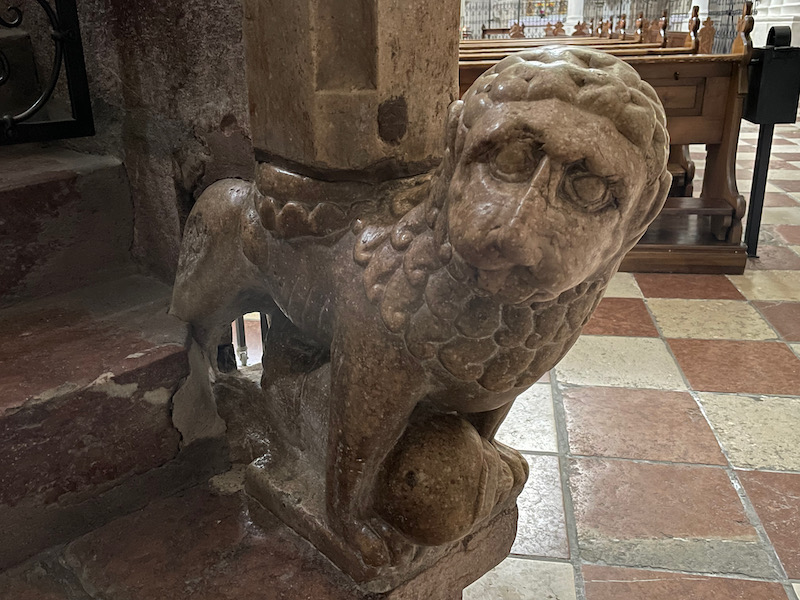 There are a couple of frescoes visible, including this one, which shows Jesus with wounds from the crucifixion.
There are a couple of frescoes visible, including this one, which shows Jesus with wounds from the crucifixion.
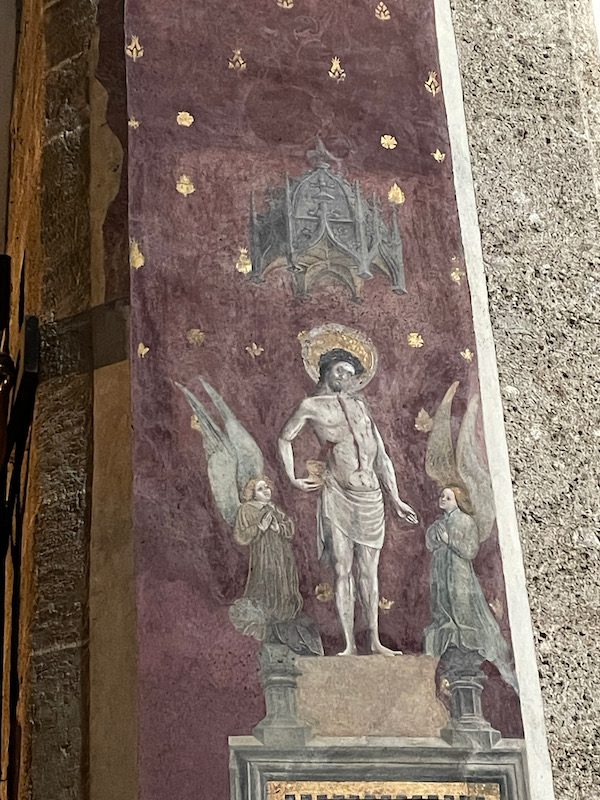 *****
*****
The Loreto Church was built from 1633 to 1648, rebuilt after a fire in 1818 and rebuilt from 1947 to 1949 after severe damage in the bombing of 1944. The church is a simple hall building with a simple, smooth facade with three attached chapels. Above the marble portal is a coat of arms of Archbishop Paris Lodron.
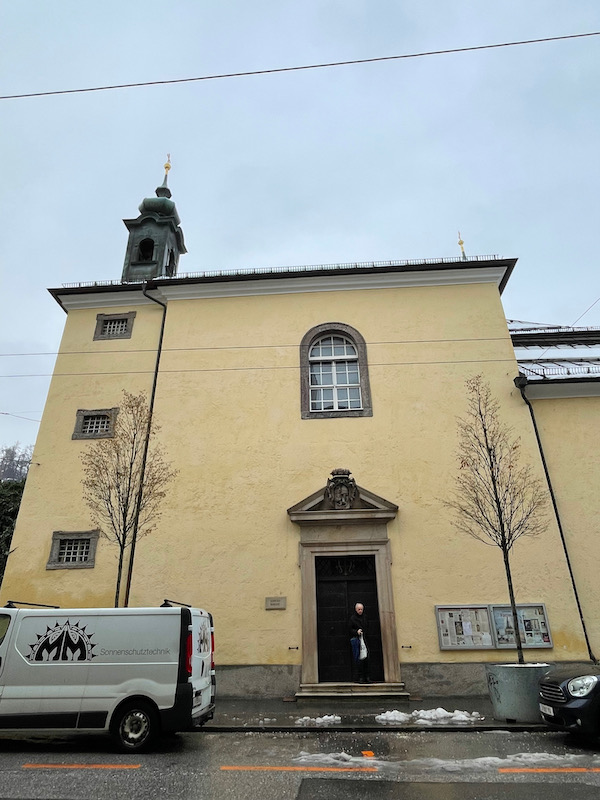
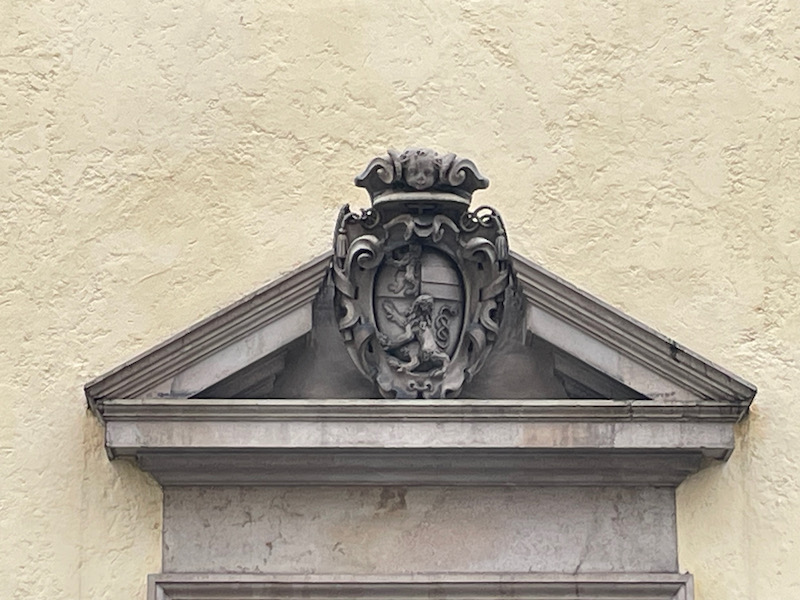
Similar to the outside, the inside is pretty plain as well, with a rectangular nave with tall white walls. There is a nice wooden coffered ceiling with medallions. If you look at the back, there are 2 side altars and then a barrel-vaulted passage that leads to the main altar.
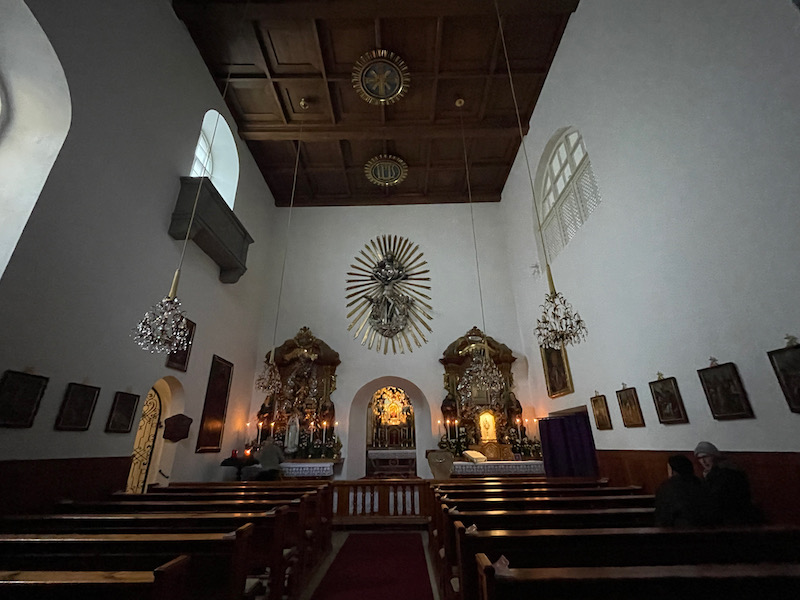
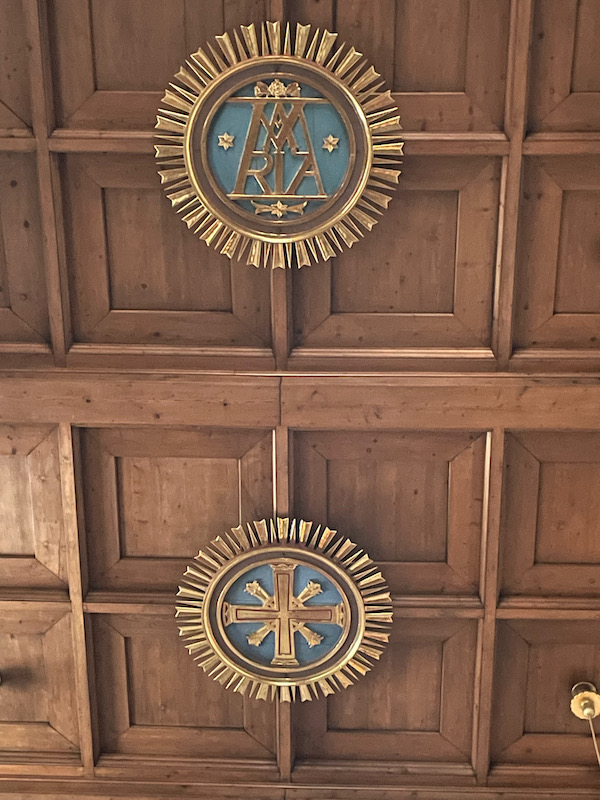
This side chapel shows the miraculous image of Maria Loreto, the saints Joachim and Anna and an angel carrying the House of Loreto (literally, a house).
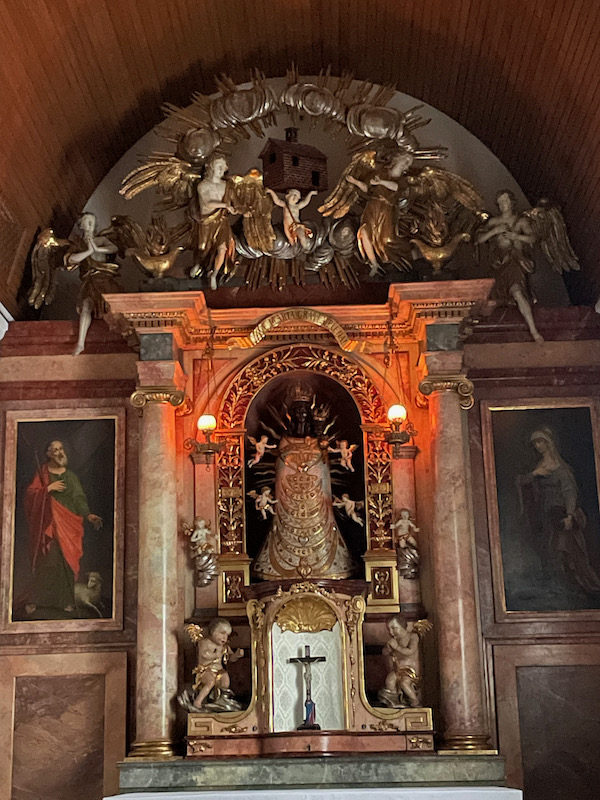
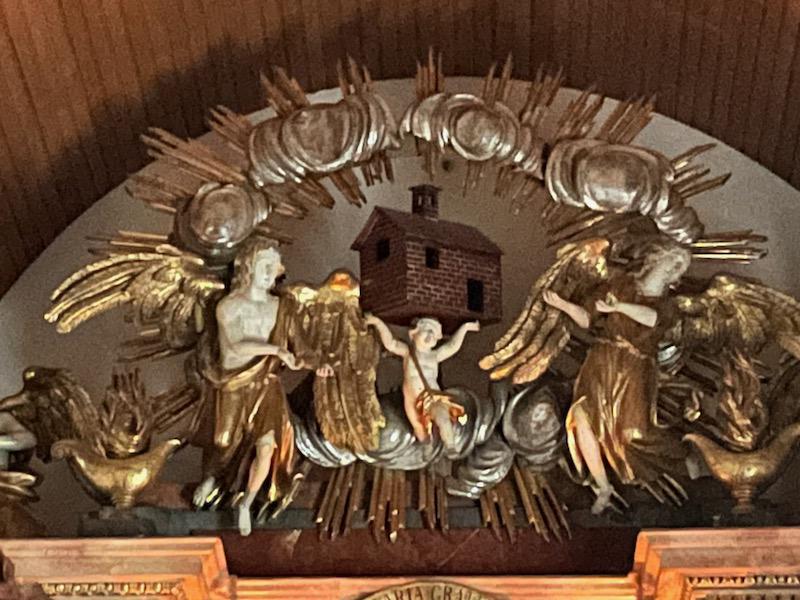
Close-up pictures of the altar on the left side of the passage leading to the main altar.
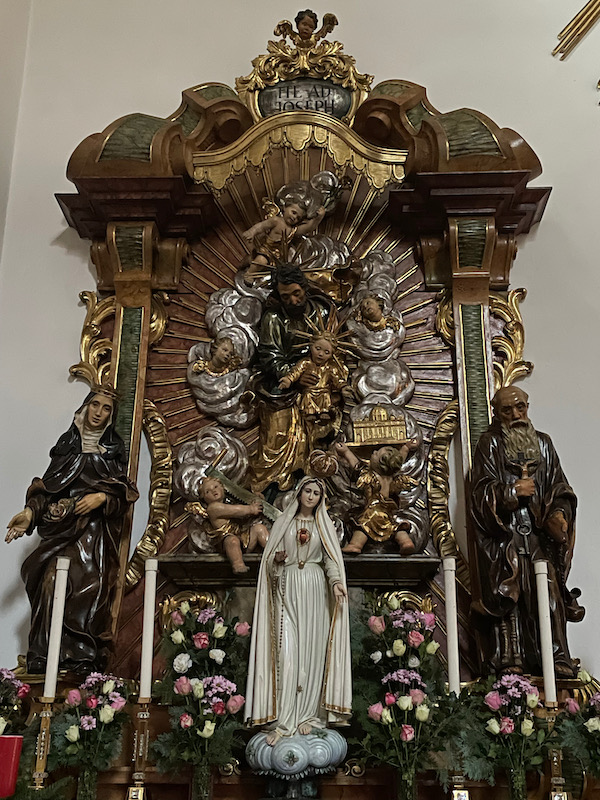
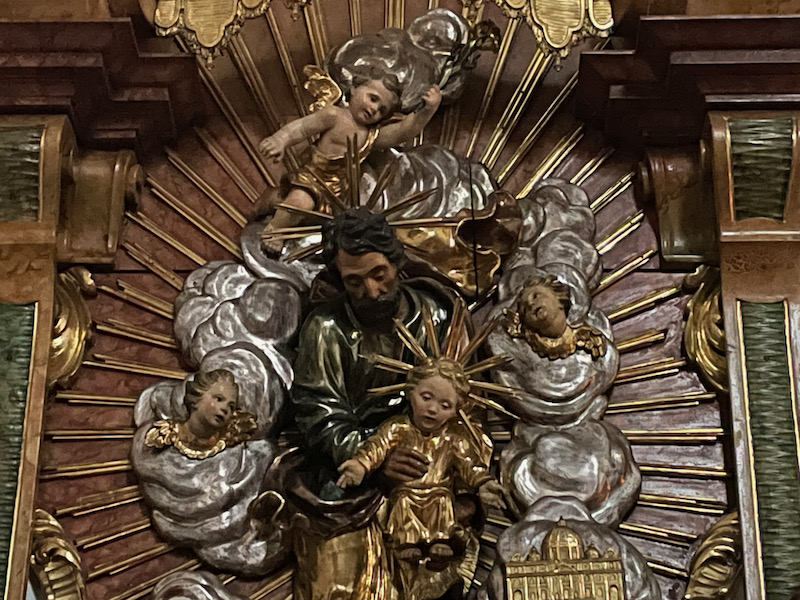
The 17th century high altar shows a Tree of Jesse and a Trinity group.
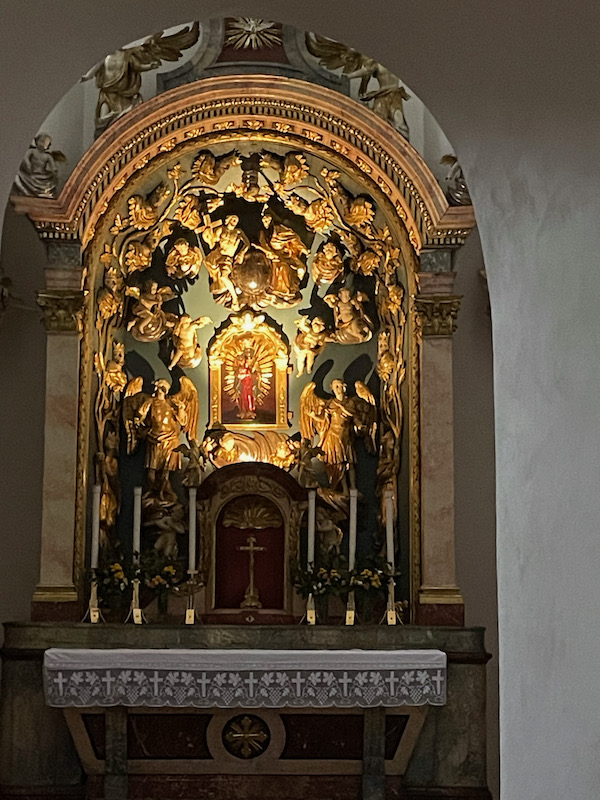
And finally, the baroque altarpiece on the right side of the passageway.
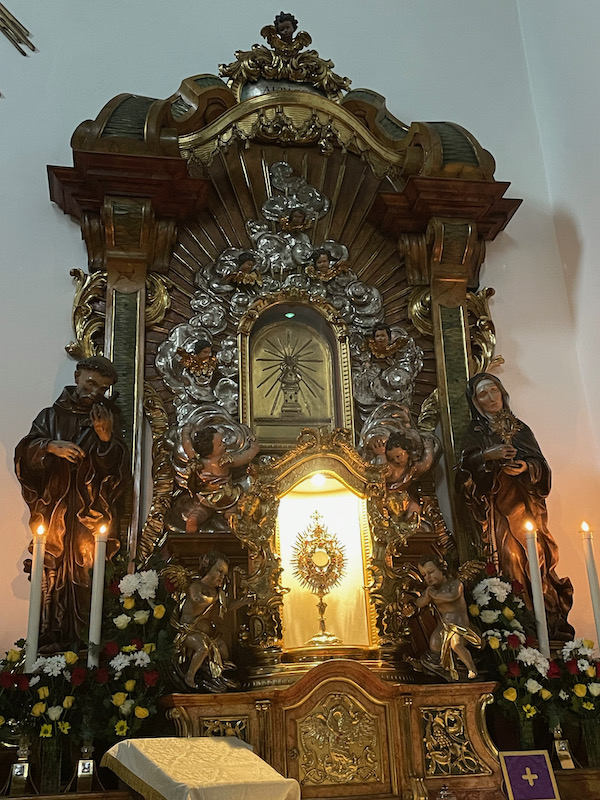
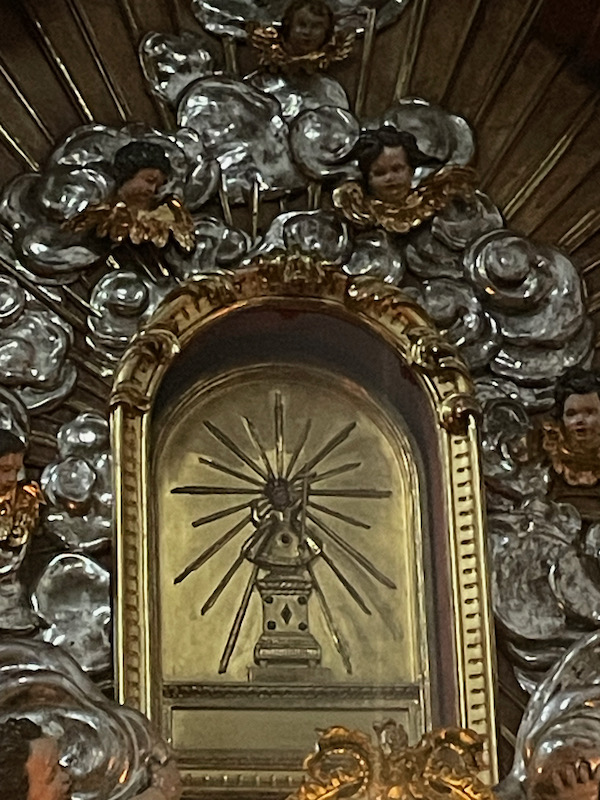
The history of the St. Sebastian’s Church goes back to Archbishop Leonhard von Keutschach. He had the church built between 1505 and 1512, only to then be replaced in the 18th century by a hall church reflecting the Late Baroque style. On the street is a magnificent Rococo portal.
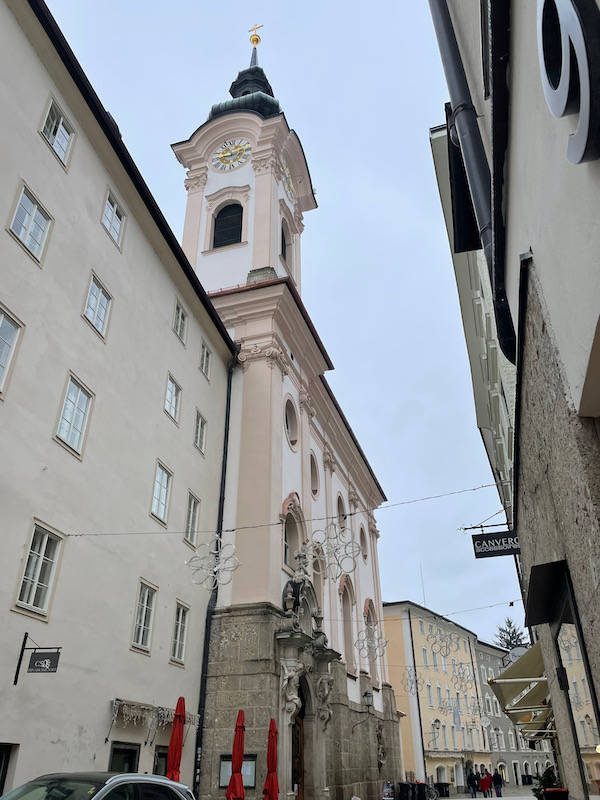
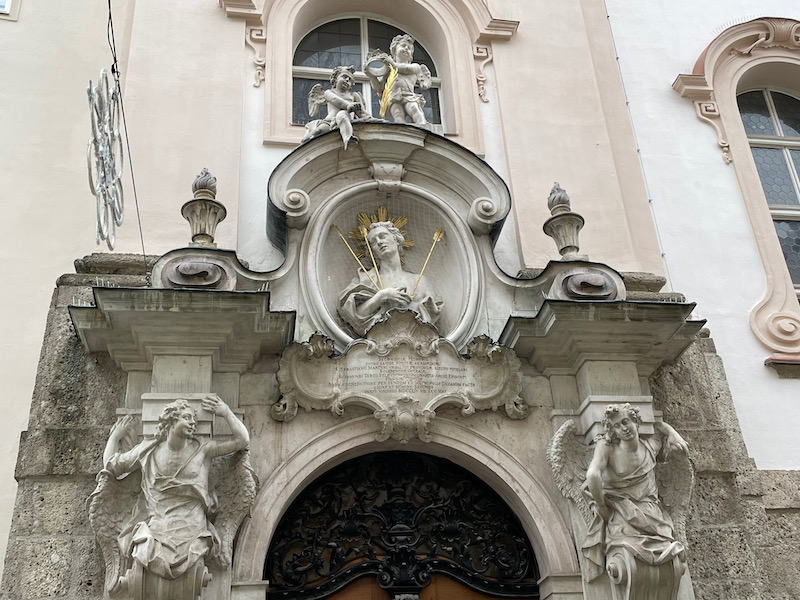
There is a metal-work gate separating the entrance porch from the main nave, so all of my pictures are from through the gate.
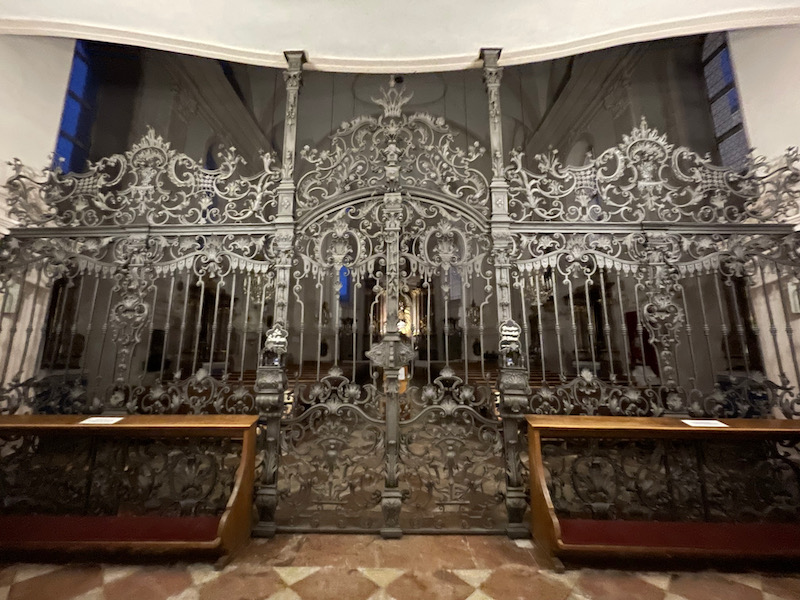
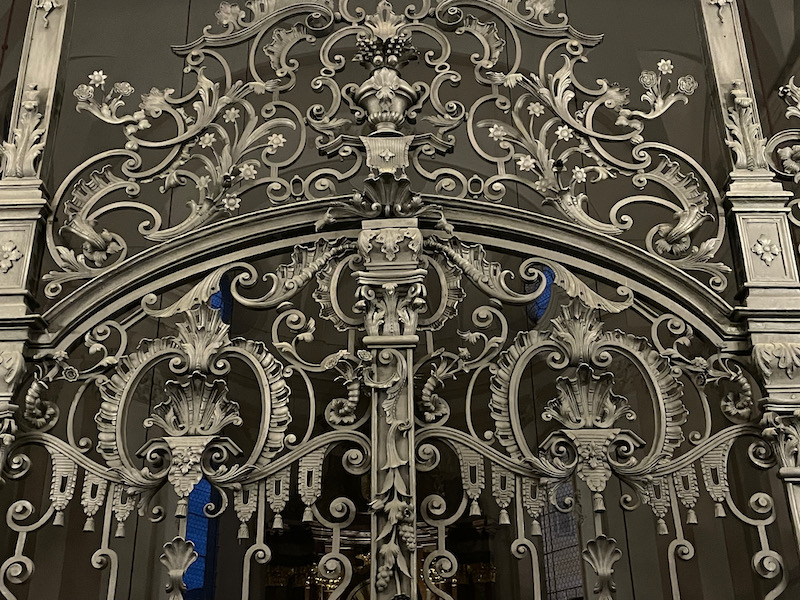
The high altar is adorned by a wonderful Madonna with Child from the year 1611.
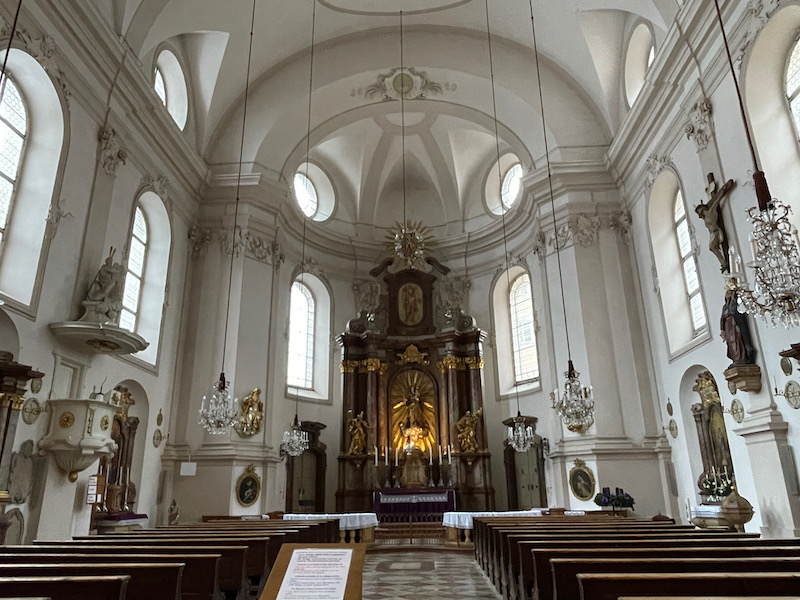

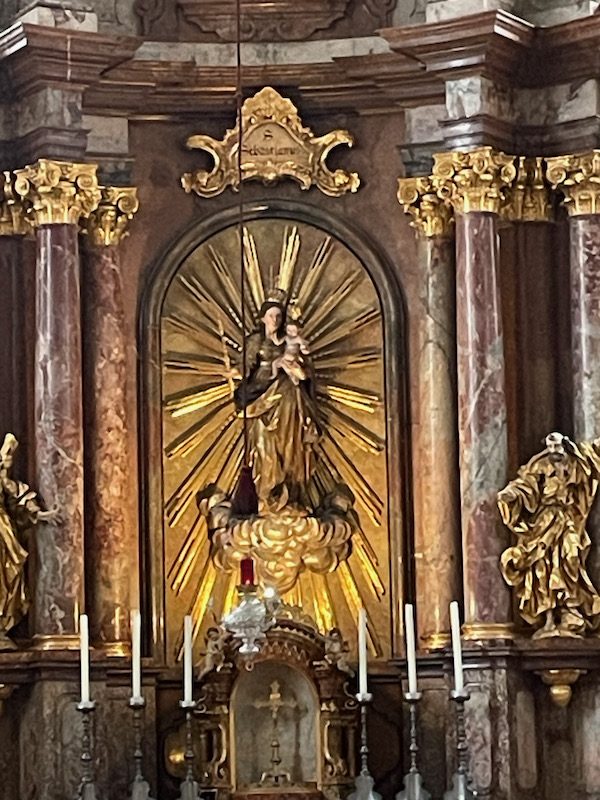
Prince-Archbishop Wolf Dietrich von Raitenau had the cemetery designed between 1595 and 1600. Members of Salzburg’s most prominent families as well as famous personalities found their final resting place here. There are some buried in the ground, as well as others in the arched arcades. Some of the memorials within the arcades are rather impressive!
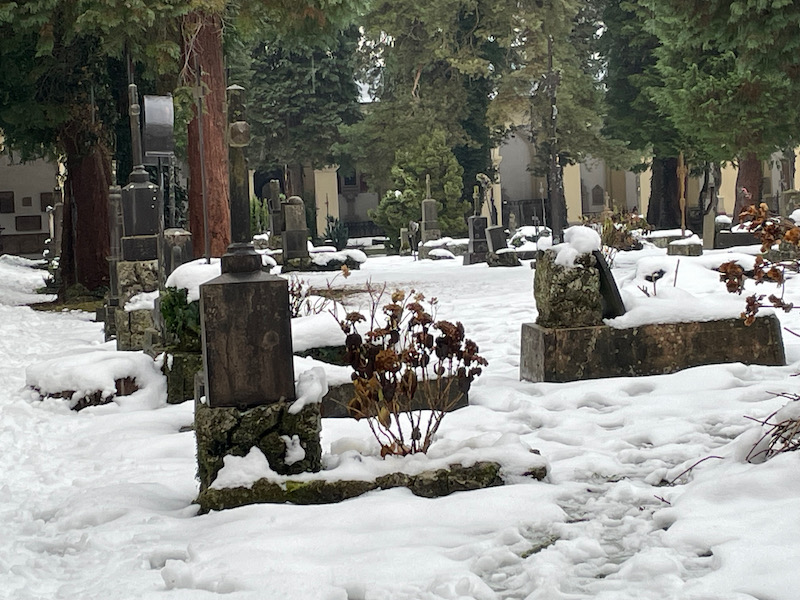
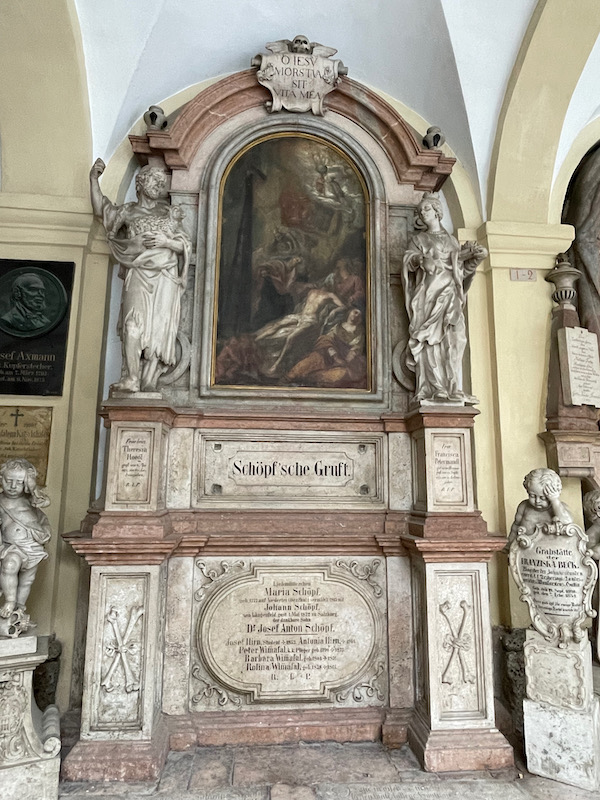
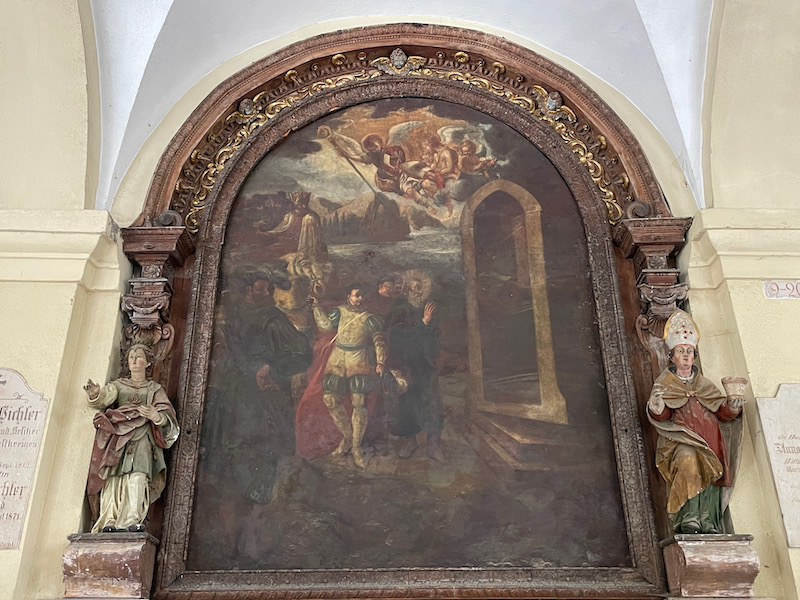
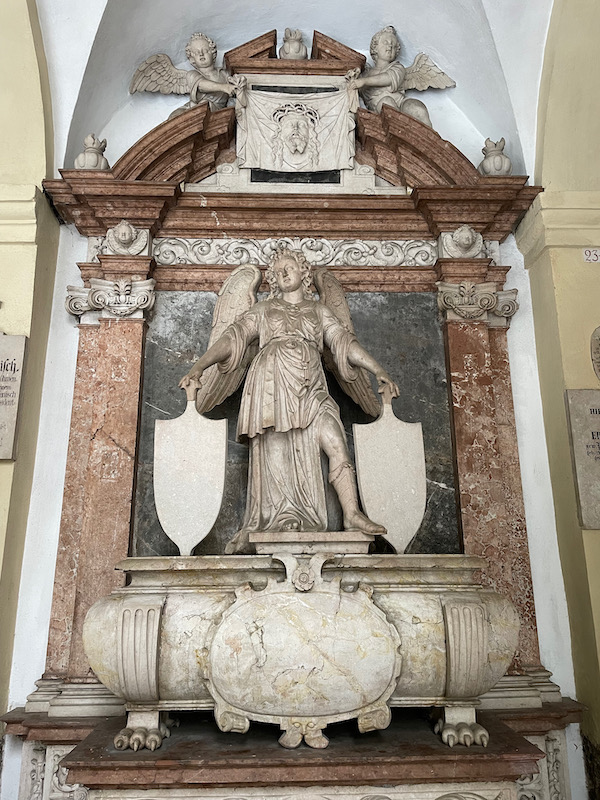
Here you can see some of the arcades and then the church in the background.
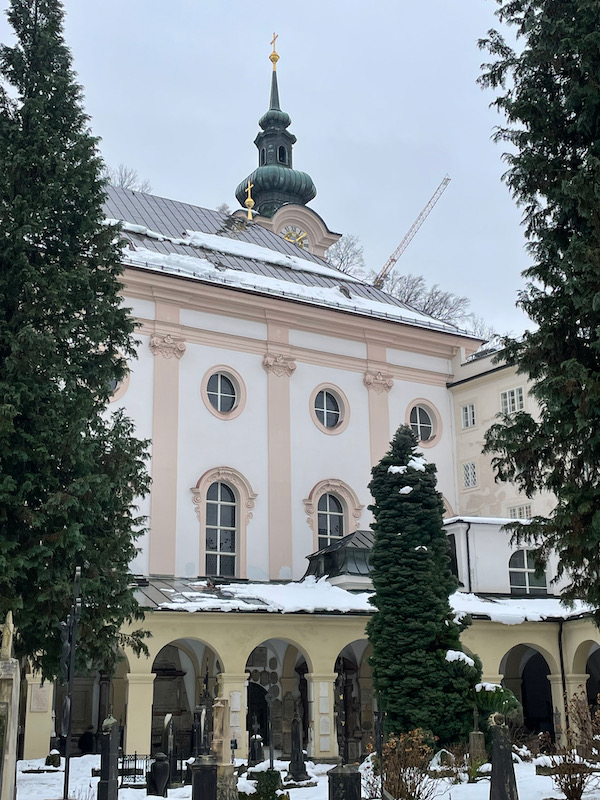
Probably the most famous of those buried here are Mozart’s father, Leopold, and Mozart's wife, Constanze.
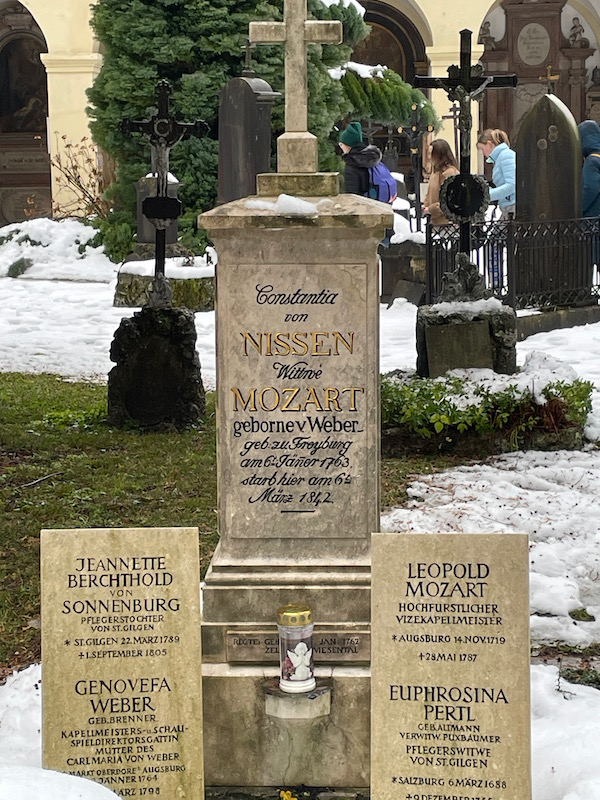
Across from the Mirabell Palace is the Church of St. Andreas. This church building is rather recent, only dating from around 1892. The original building was closer to the river but turned into apartments and retail space in 1861. This new church was built in the Neo-Gothic style, with red brick walls and a red roof. However, the 1944 air raids did quite a bit of damage and when it was restored, the Neo-Gothic appearance was not restored. You still get a little bit of the Gothic feel with the arches over the doors and windows.
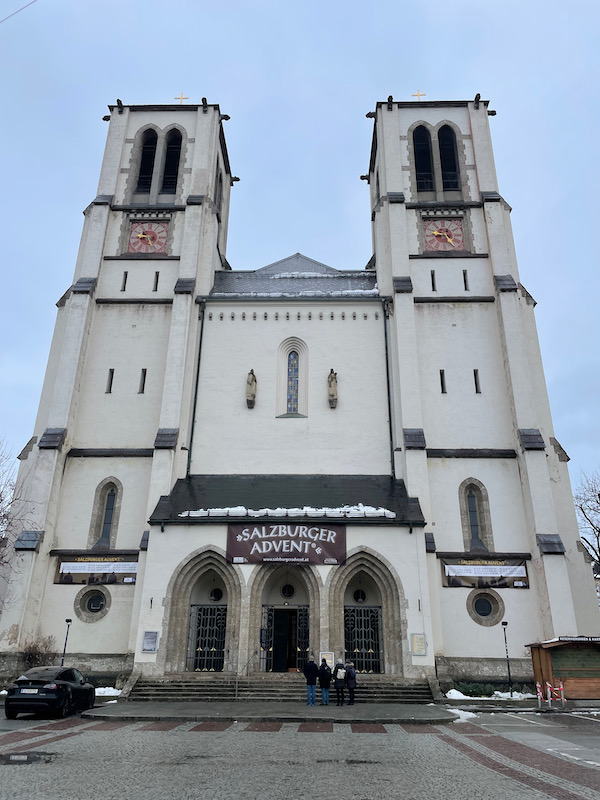
Inside, you have Gothic arches that separate the nave from the side aisles, along with a barrel-vaulted wooden ceiling.
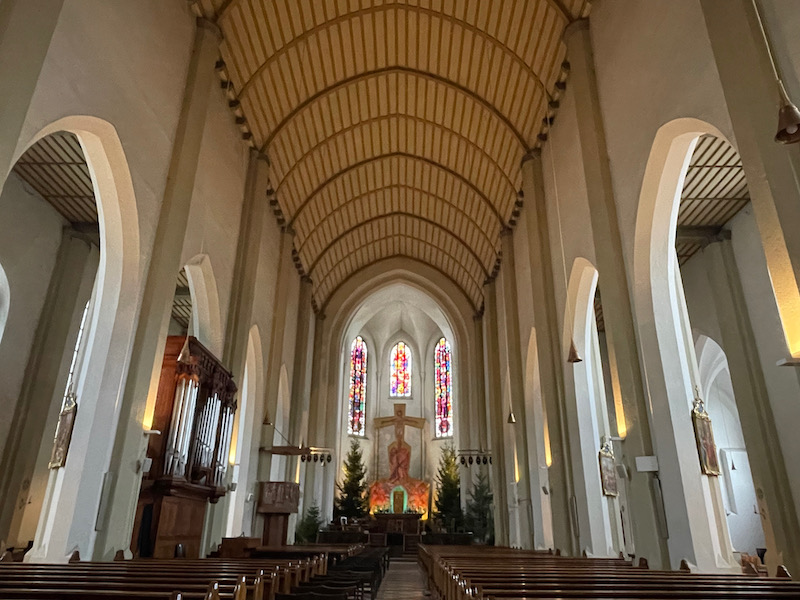
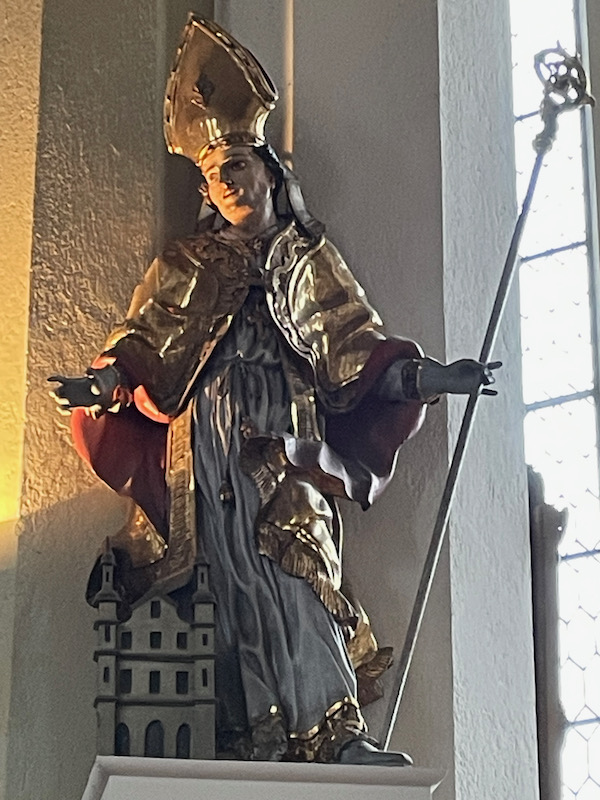
The stained glass windows are more recent and modern.
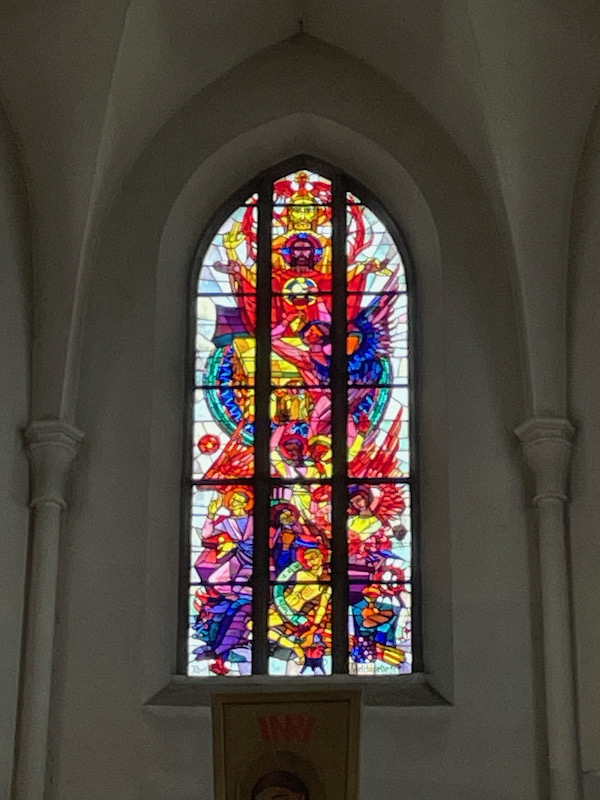
The Mirabell Palace was built around 1606 for Prince-Archbishop Wolf Dietrich Raitenau and his mistress and was originally named Schloss Altenau (mixing the last name of his mistress, Alt, with the ending of his own name "enau"). When he was arrested, his successor kicked the mistress and her family out and renamed it Mirabell (Italian for amazing or wonderful). It was rebuilt in a lavish Baroque style from 1721 to 1727. The current appearance is Neoclassical and dates from 1818, when it was restored after a fire.
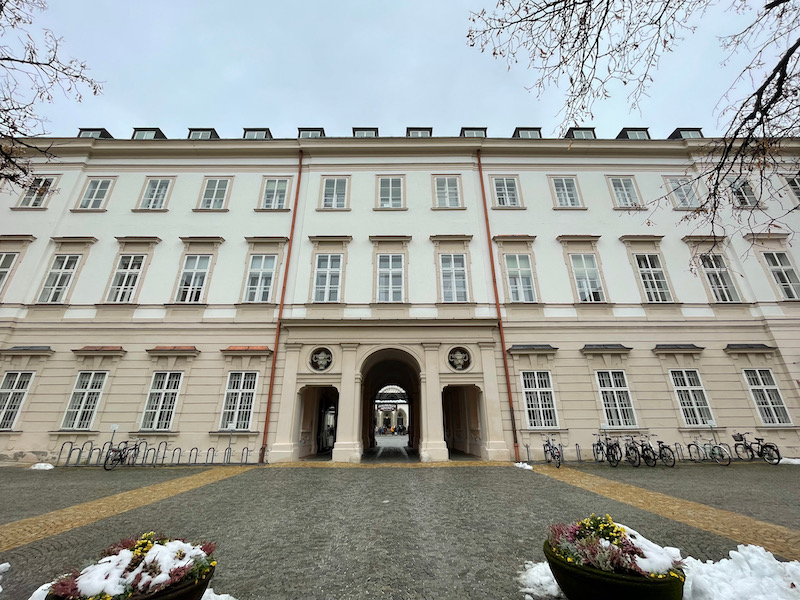
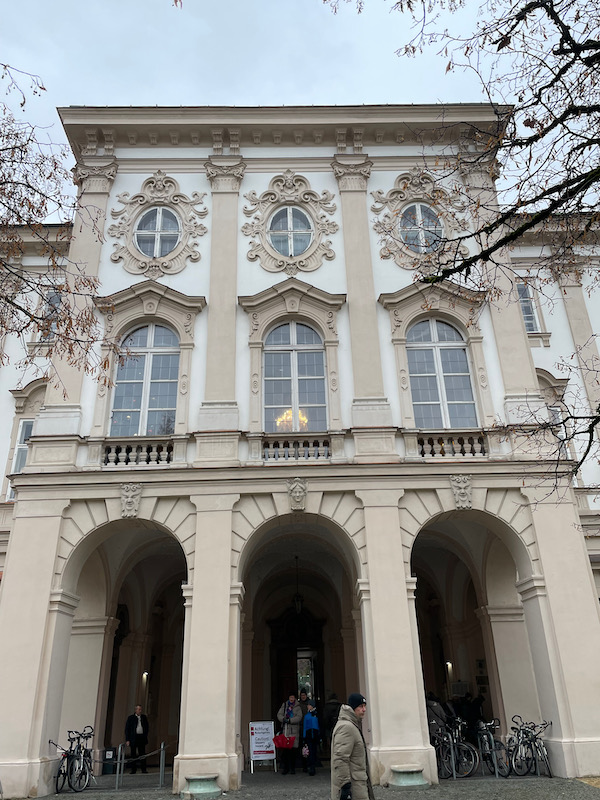
Most of the palace was closed, including the famous Marble Hall (where they do concerts throughout the year). However, we could walk up the Angel Staircase and check out the various cherubs and different Greek and Roman statues.
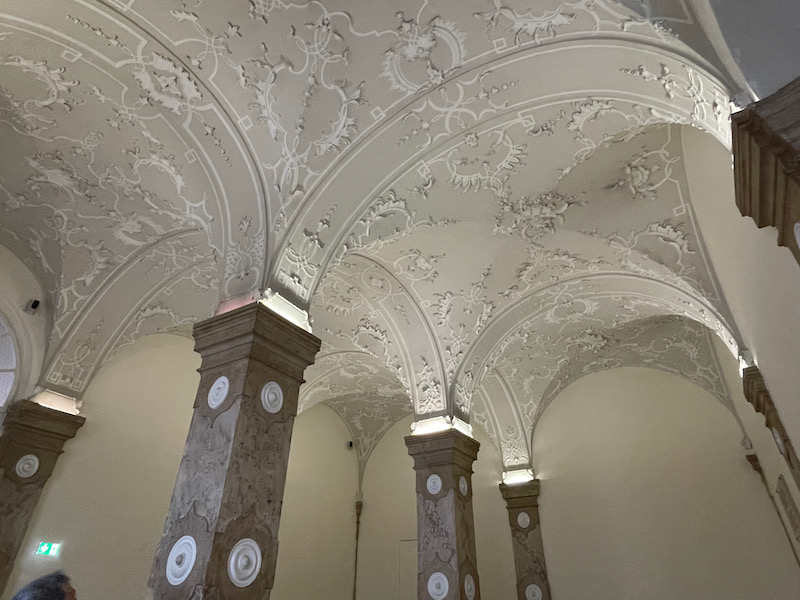
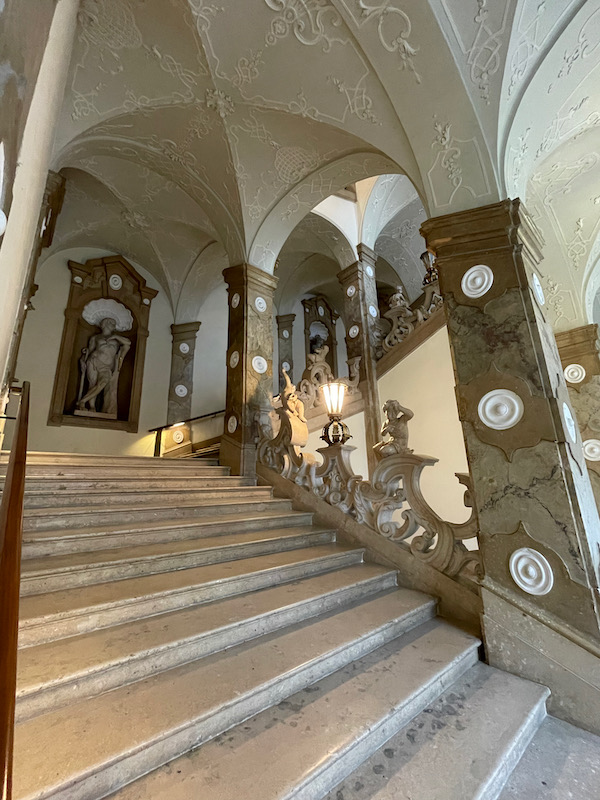
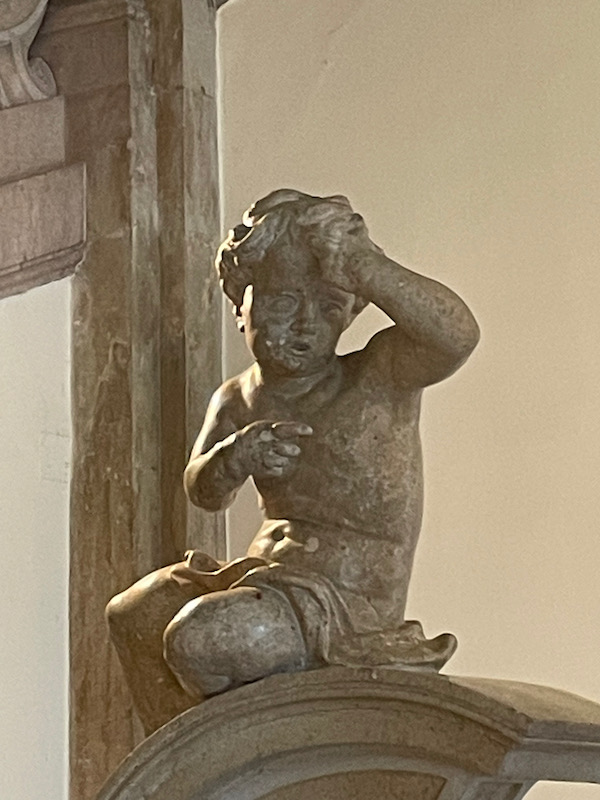
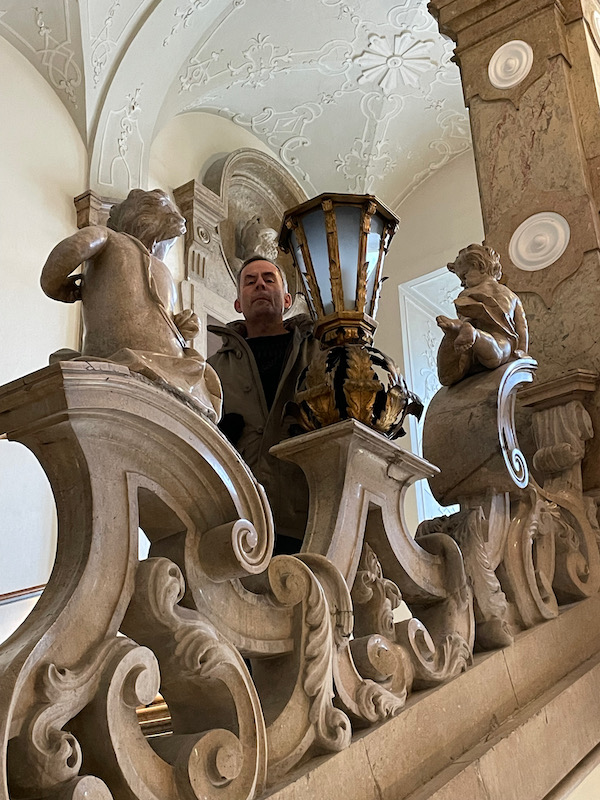
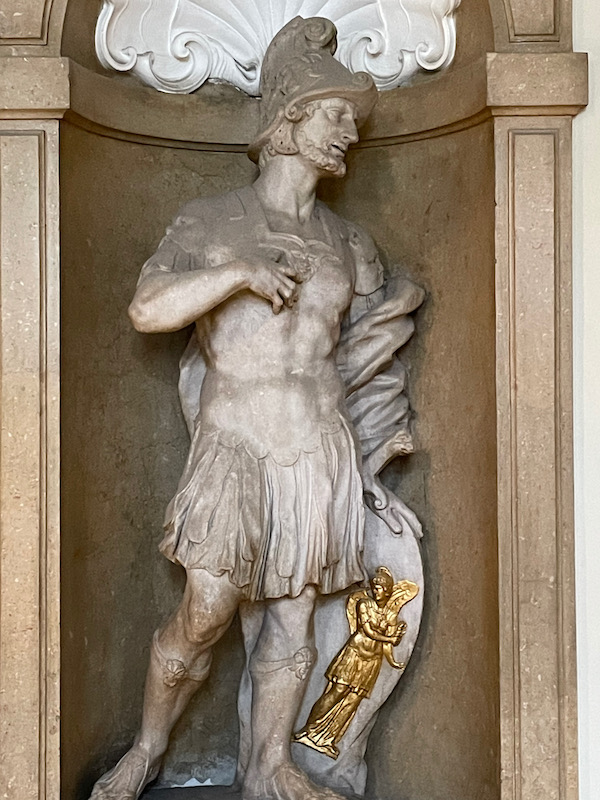
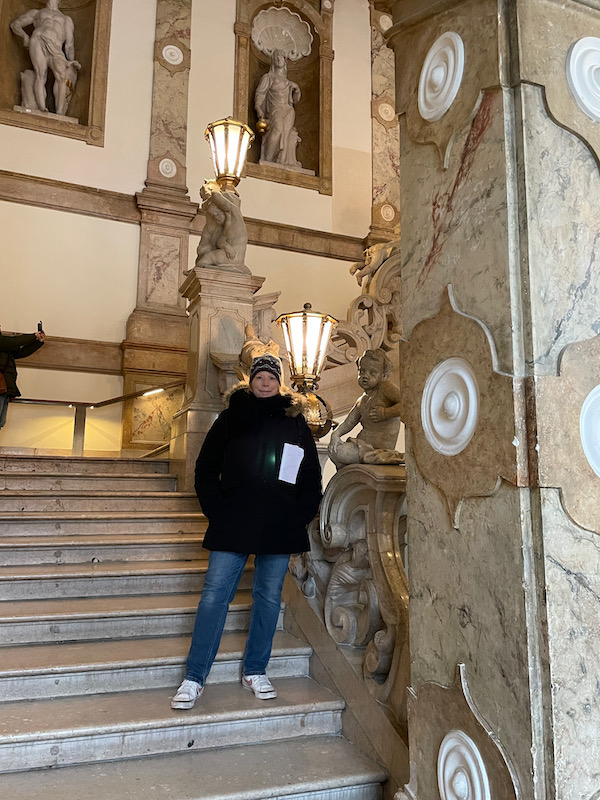
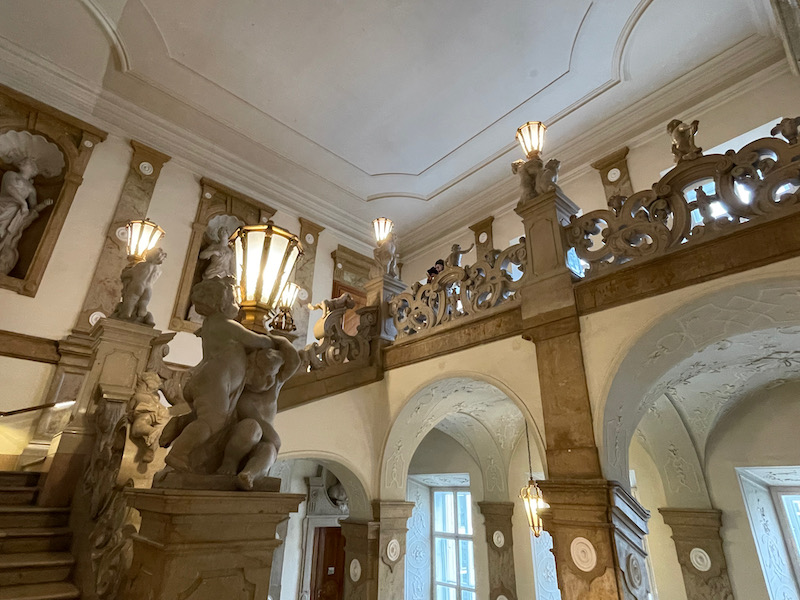

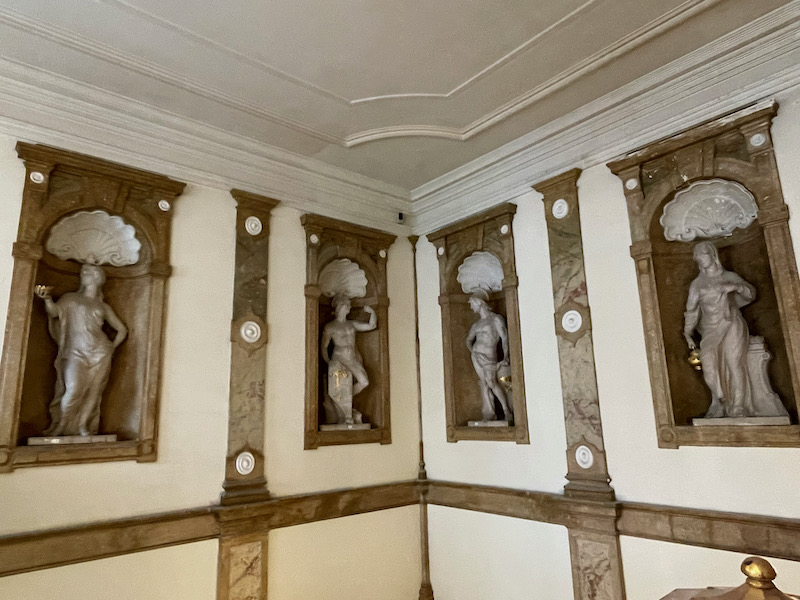
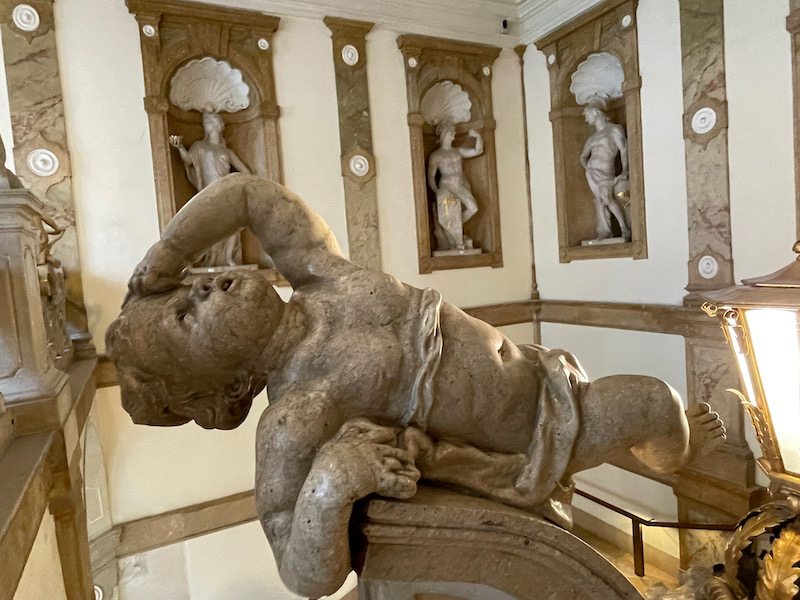
We then headed out to go through the gardens, which was one of the shooting locations for the musical "The Sound of Music" with Julie Andrews. As part of the "Do Re Mi" song, the von Trapp family go around the Pegasus Fountain (it looks much warmer in the clip than it was when we were there ... you can see the snow and ice behind me!).
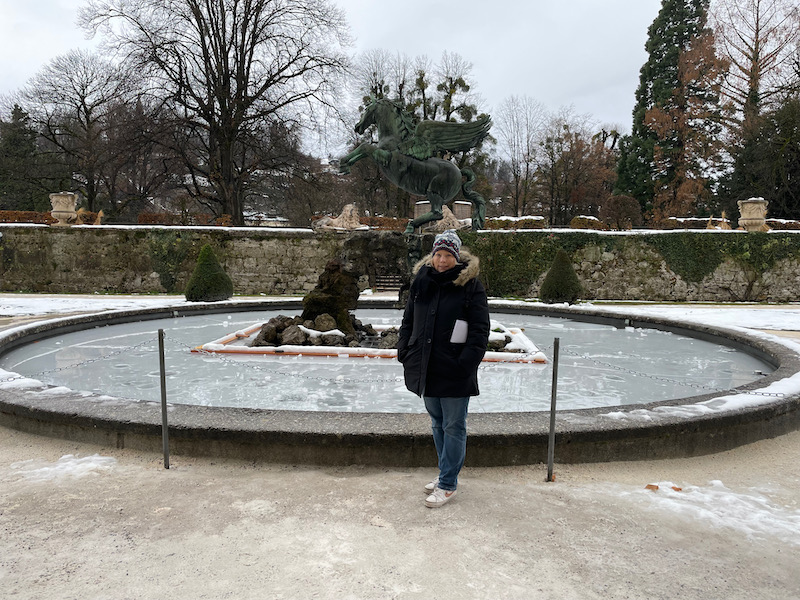
If you want to see the clip, I found a little clip on YouTube ... head to about 1 minute in, you will see the Pegasus fountain with the kids going around. Then, there are various statues that can be seen as they go through the gardens.
And finally, another outside picture and then a view across the gardens to the fortress on the cliff.
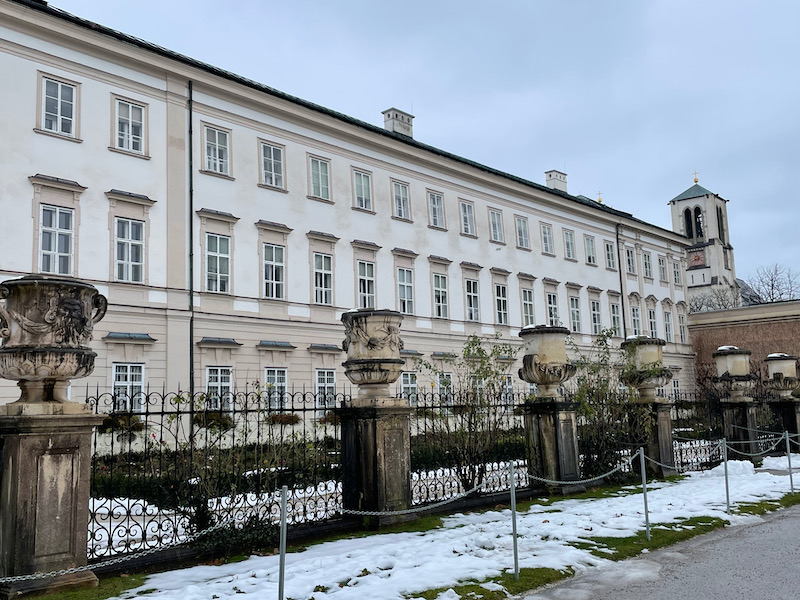
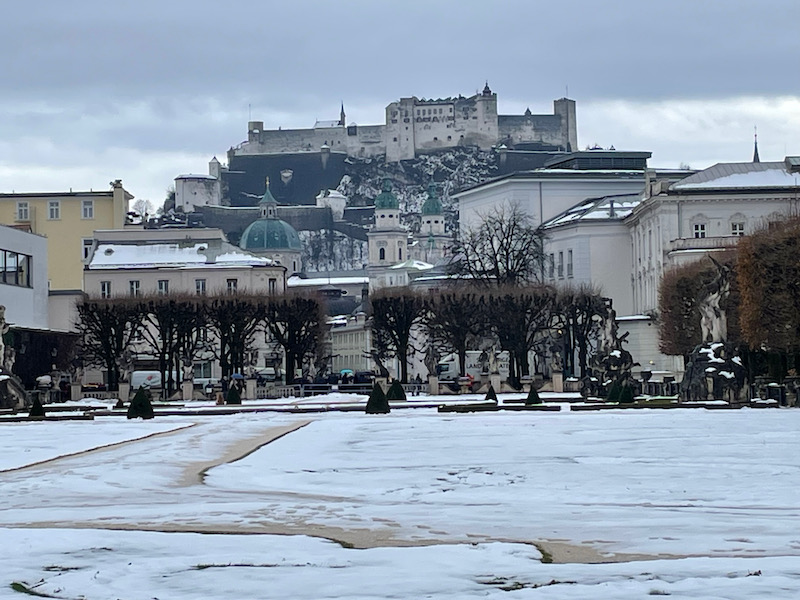
Then we did a bit of walking around and saw a few interesting buildings. One had this stone angel on the side, and then a gorgeous building that now houses a Foot Locker. Interesting this about this building is ... it was the prior building for the Church of St. Andreas that we saw a little bit ago across from the Mirabell Palace (remember I said it was converted to apartments and retail space in 1861).
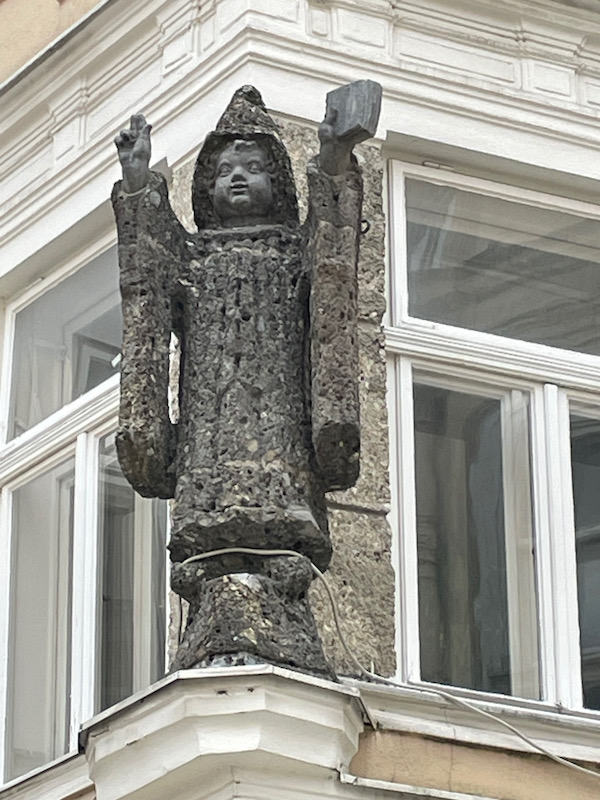
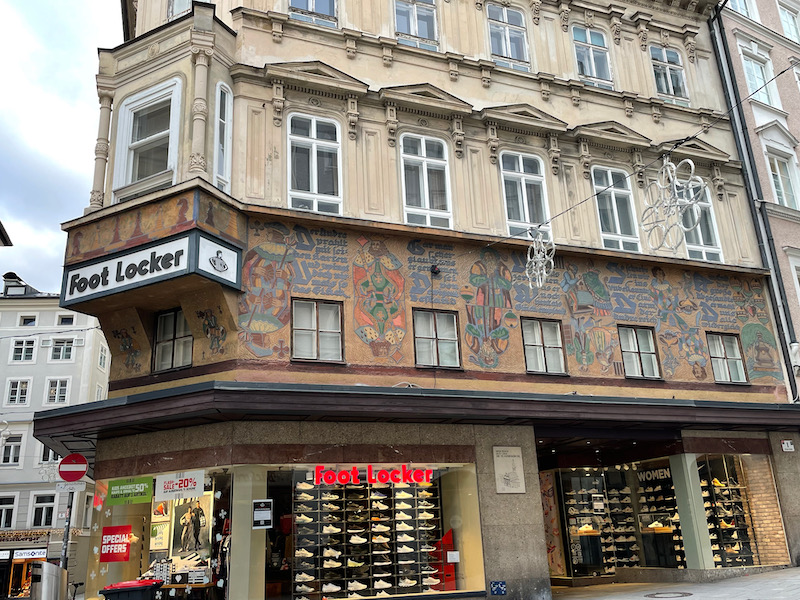
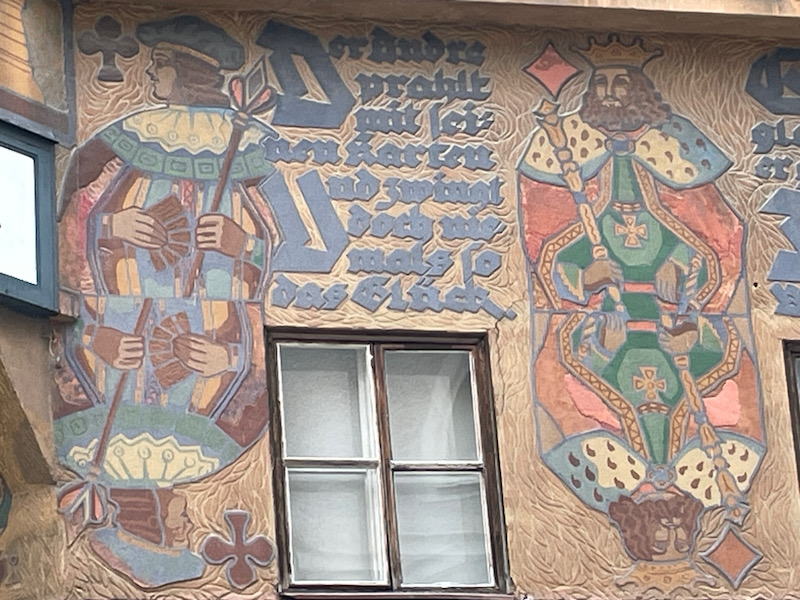
Then back across the river to the Cathedral side, we saw a few more buildings that had similar bands of artwork on them.
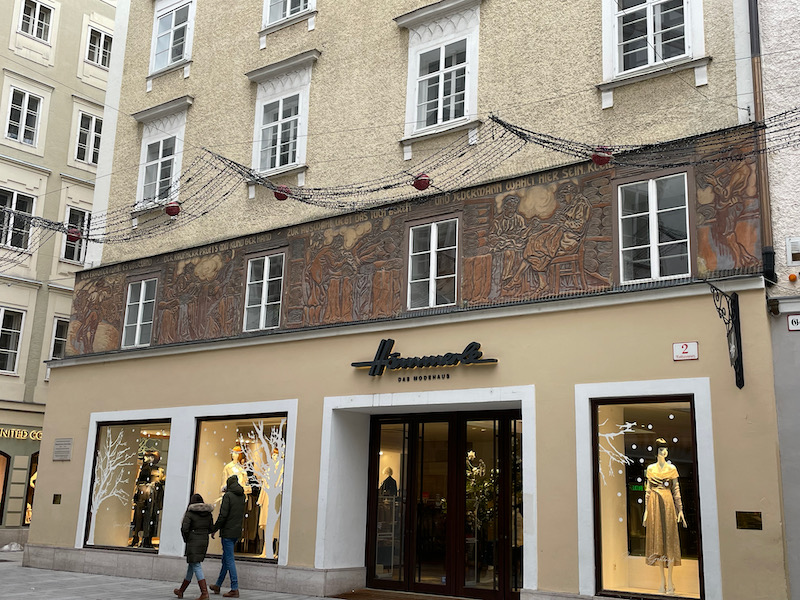
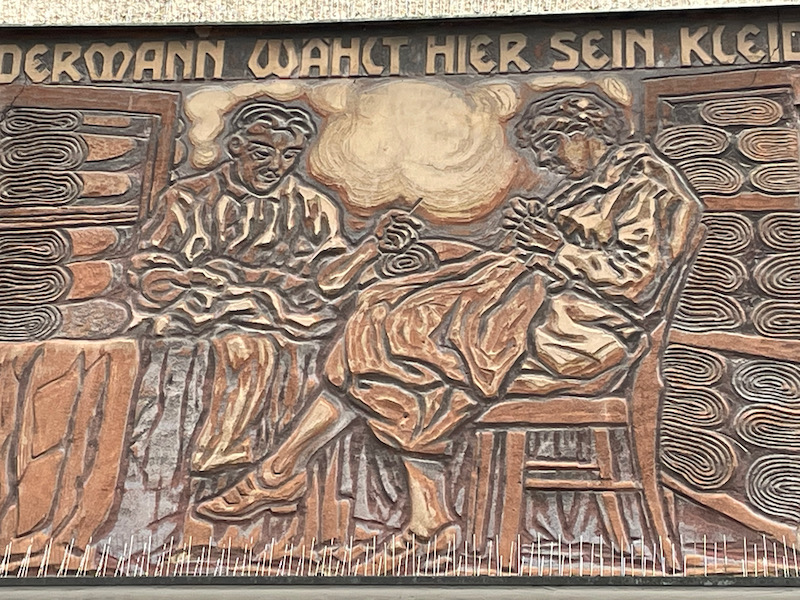
I have mentioned Mozart several times so far ... this building is the birthplace of Wolfgang Amadeus Mozart. The family resided on the 3rd floor from 1747 to 1773 while his father, Leopold, was a musician in the Salzburg Royal Chamber. There were 7 Mozart children born here, although only 2 survived ... Wolfgang in 1756 and Maria Anna in 1751. It now houses a museum that has exhibits on his early life, his early instruments, including the clavichord on which he composed The Magic Flute.
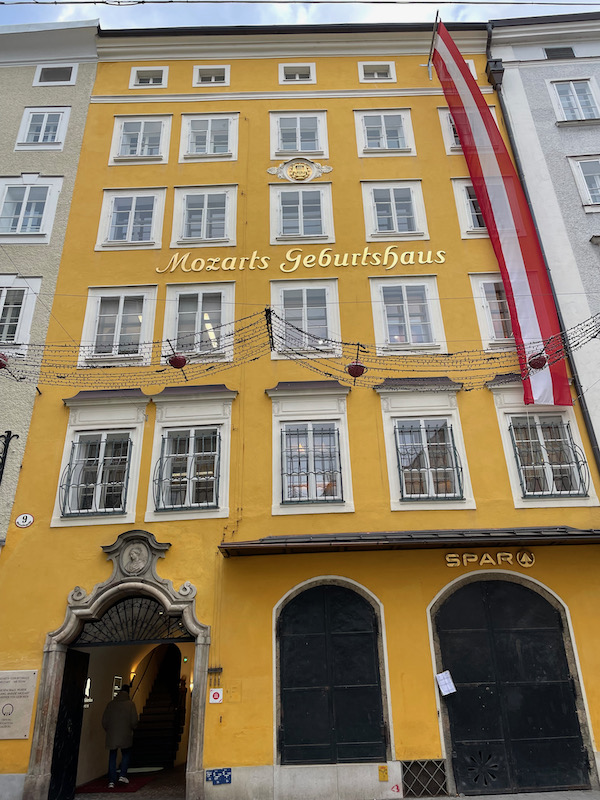
In various towns across Germany, I have mentioned these metal shop signs ... well ... there were quite a few interesting ones here in Austria as well, including one from a McDonalds (which is no longer there but the sign remains).
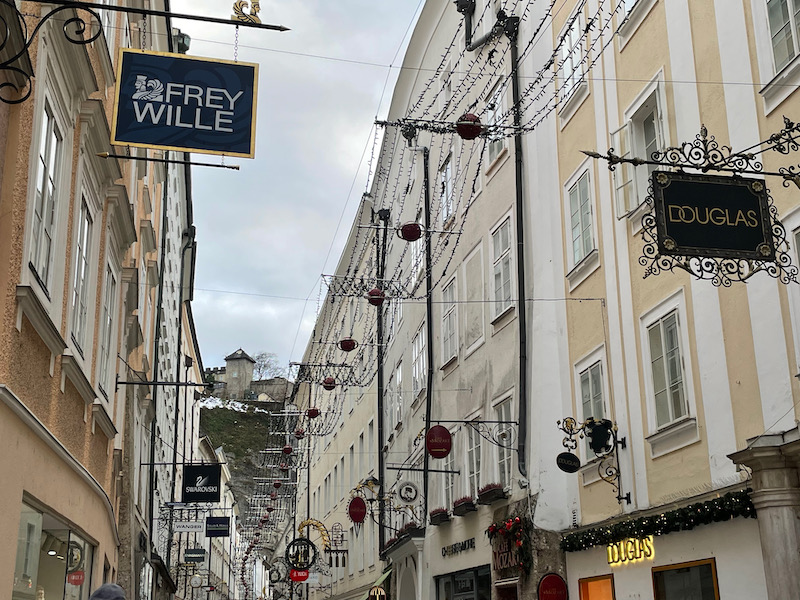
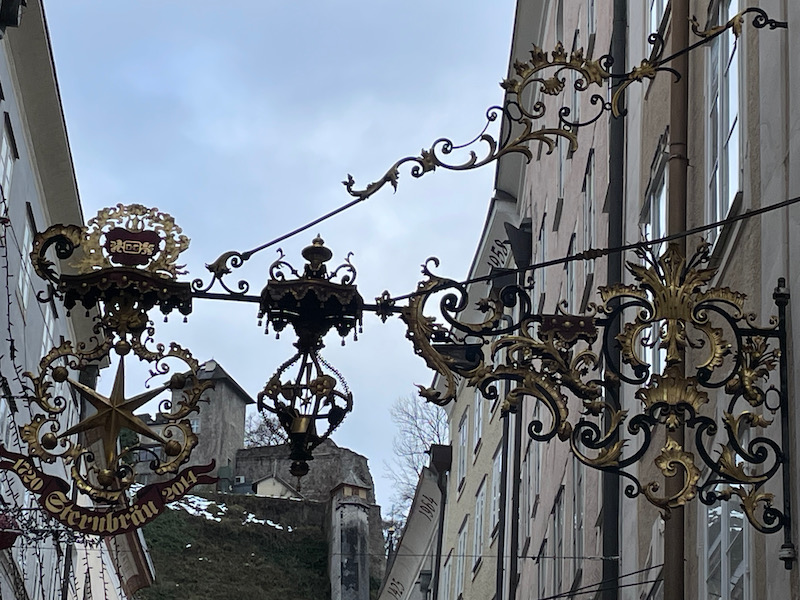
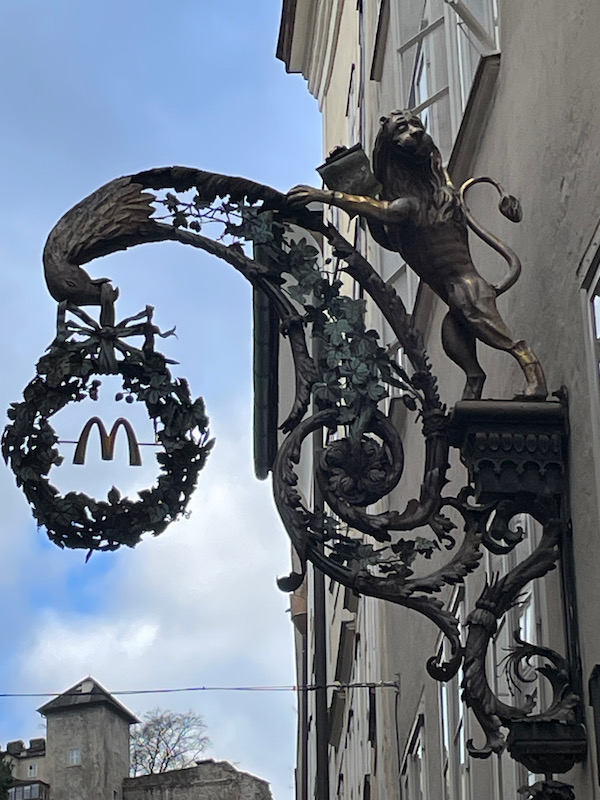
The Gstättentor Gate is one of the oldest ancient gates into the city. The gate and some of the surrounding walls are part of the oldest sections, dating from the 13th century. The coat of arms of Sittikus can still be seen on both sides of the gate. On the outside of the gate, you can see how the buildings are built almost literally up against the tall rocks. As you can see from the dates on the top, some of them date back to the 1400's but have been renovated.
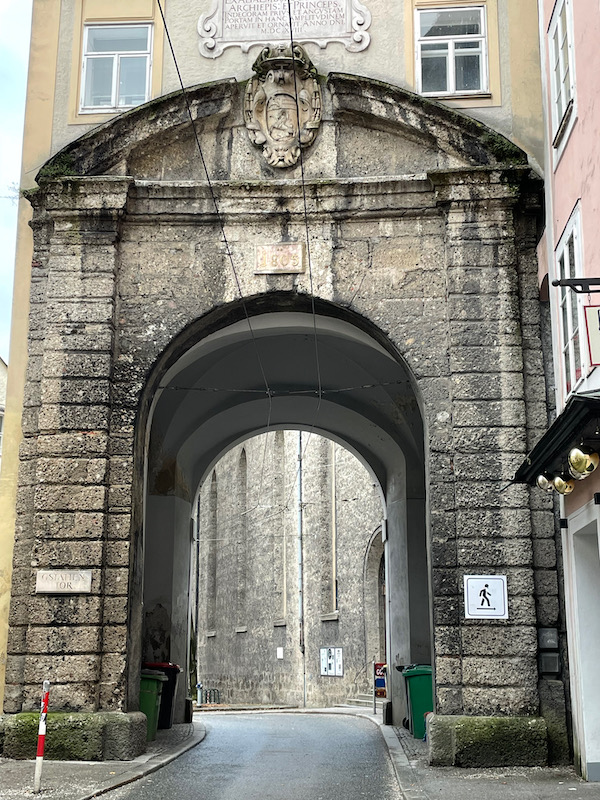
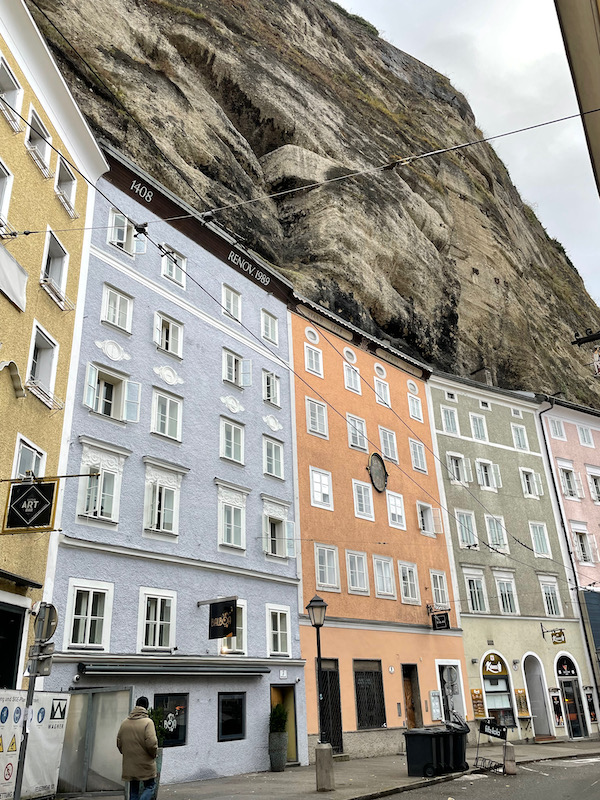
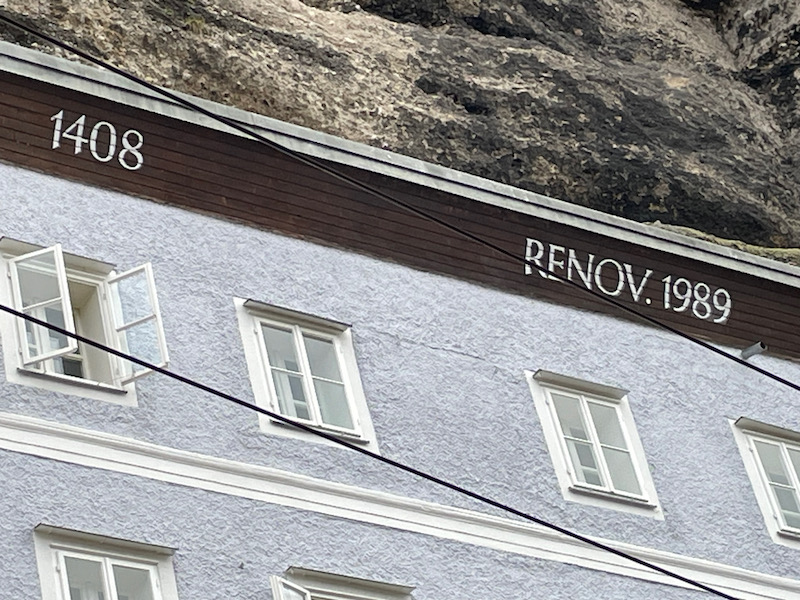
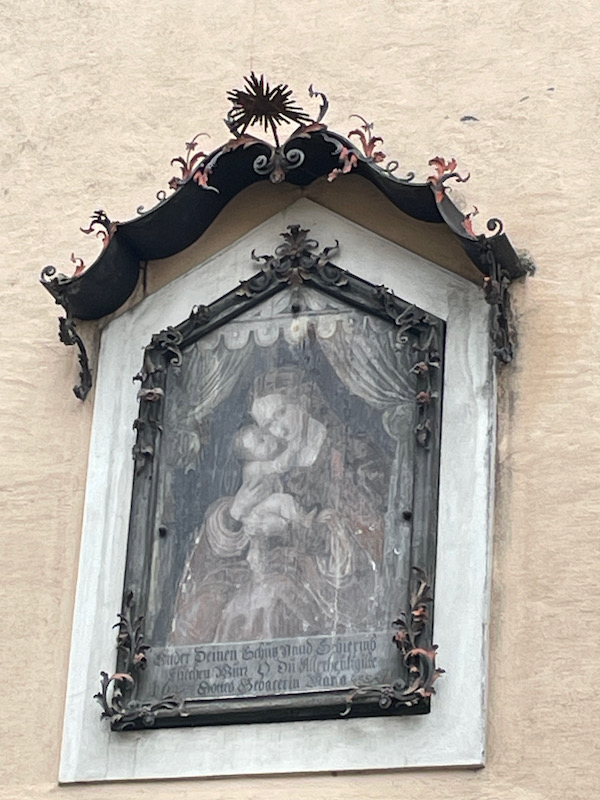
The Pferdeschwemme was part of some court stables that date back to the late 1600's. During a redesign in 1695, this horse floodplain (this is like a large trough for horses to bathe or drink) and a fountain. Not that you can see the statue in the middle well (it was covered I assume for the winter), it is called The Horse Tamer and shows a man taming a rearing horse. The balustrade around it dates to 1732, as does the wall with the paintings with 11 different horses (the paintings themselves have been updated multiple times, most recently in 1960.
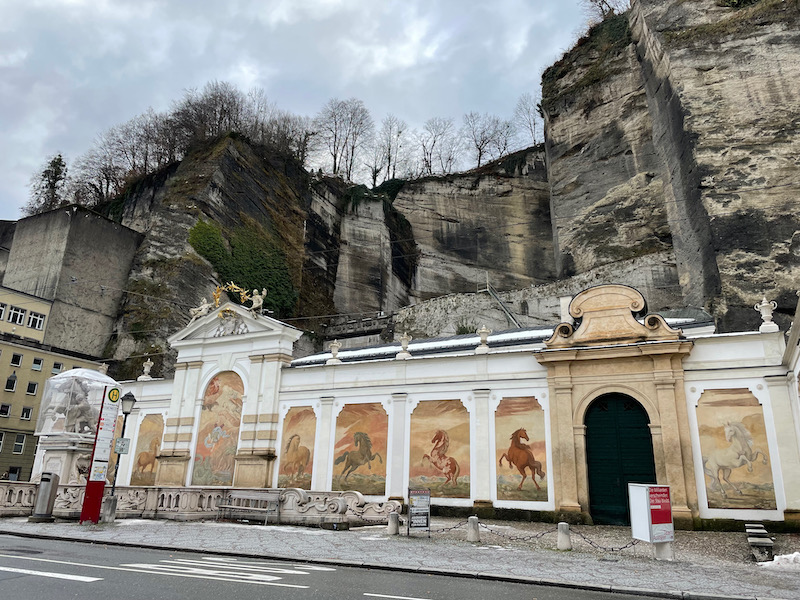
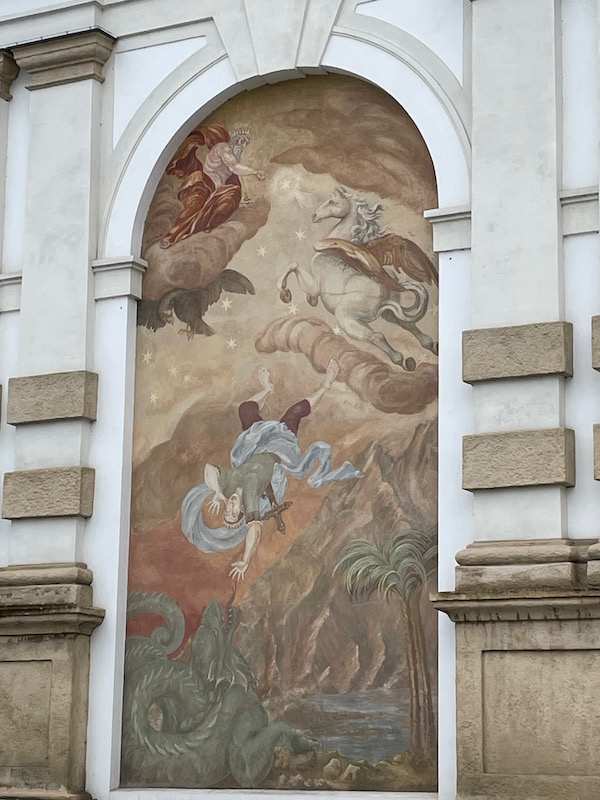
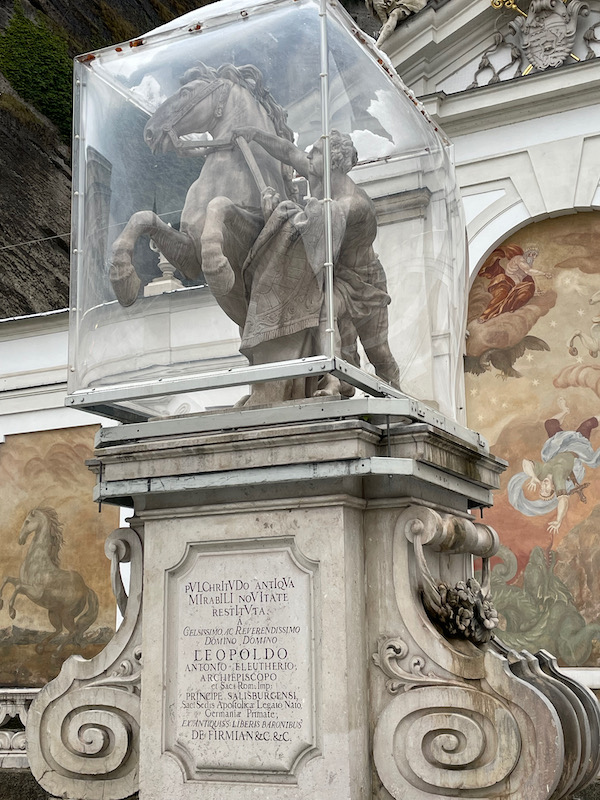
Wilder Mann Brunnen, or the The Wild Man Fountain, is one of the former fountains from the Salzburg fish market and was used from 1641 to 1925. The fountain got its name from the statue on top of it. The long club in one hand is reminiscent of a trident, and the other hand holds the Salzburg city coat of arms.
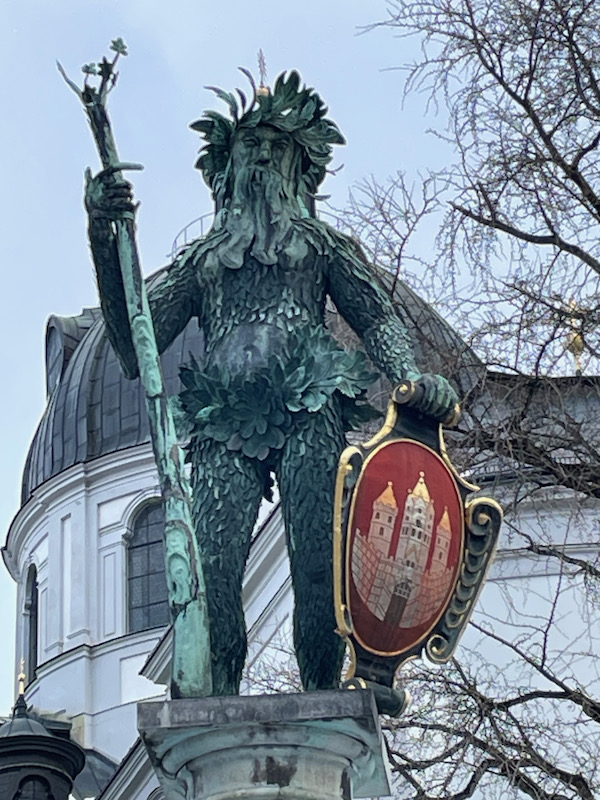
St. Peter's Abbey, Church, and cemetery St Peter's Abbey is a Benedictine monastery, considered one of the oldest monasteries in the German-speaking area with a continuous history since its foundation in 696 by Saint Rupert.
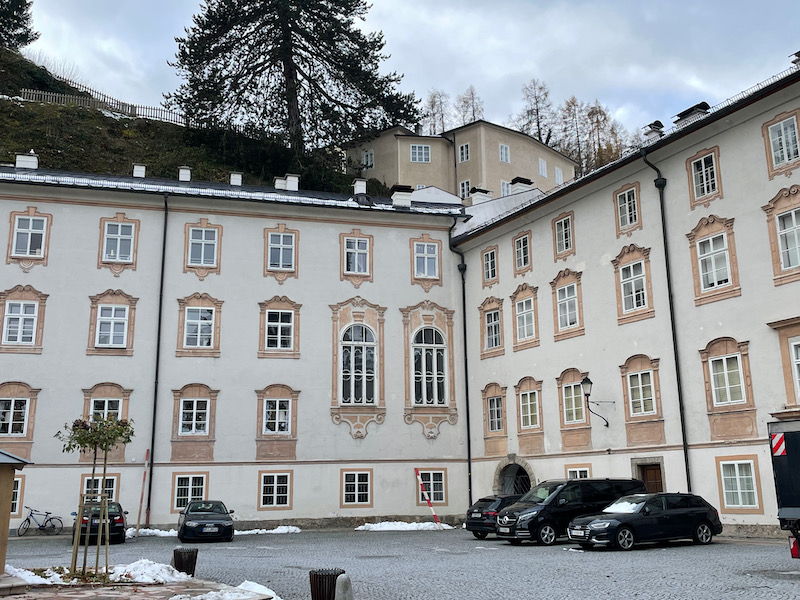
Today's Abbey Church was built in the 12th century and remodeled several times over the centuries, and today combines elements of Romanesque, Gothic, Renaissance, Baroque and Rococo styles. The main portal dates from around 1250, with carved wooden doors and a iron-work grill above it. The tympanum above the gate dates from around 1160 and shows a relief with Christ enthroned on a rainbow as Savior and Judge of the world between the Saint Peter and Saint Paul. The two trees with the pigeons sitting on them are symbols of peace. Heading inside, here is yet another church with a grille, this one in Rococo style dating from 1768.
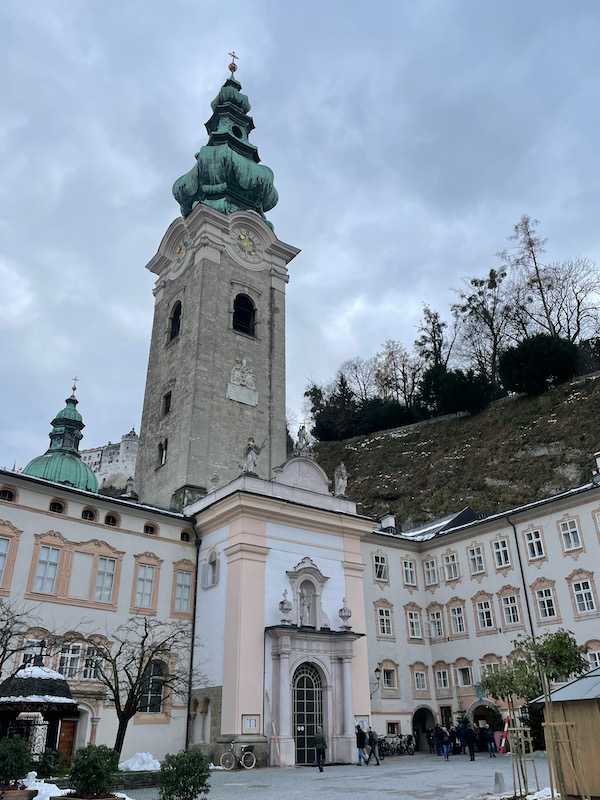
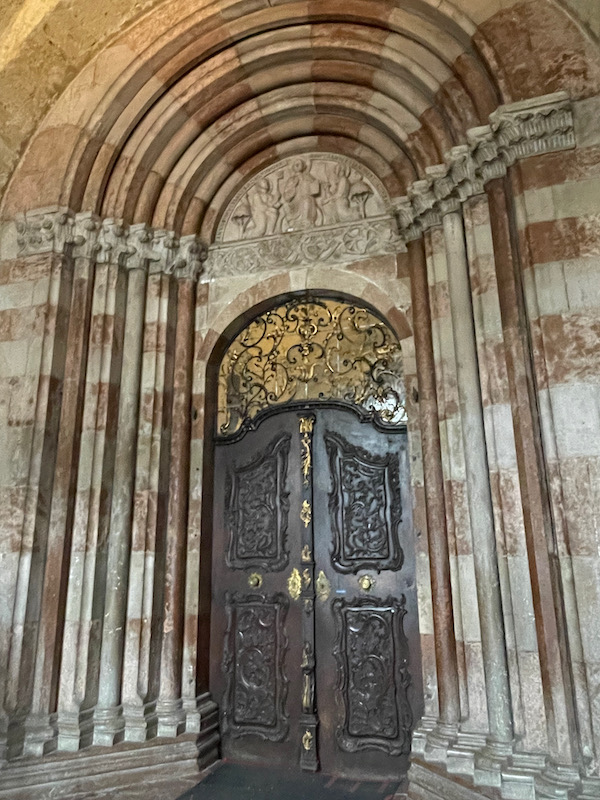
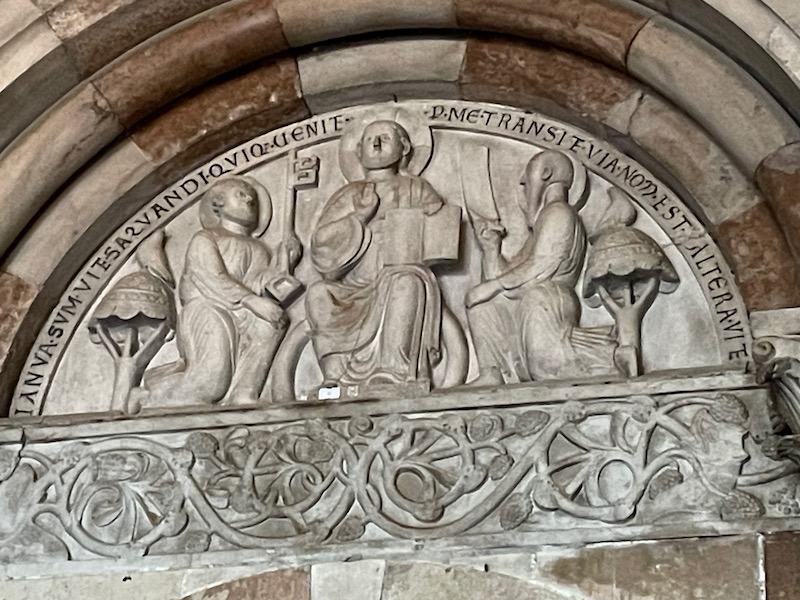
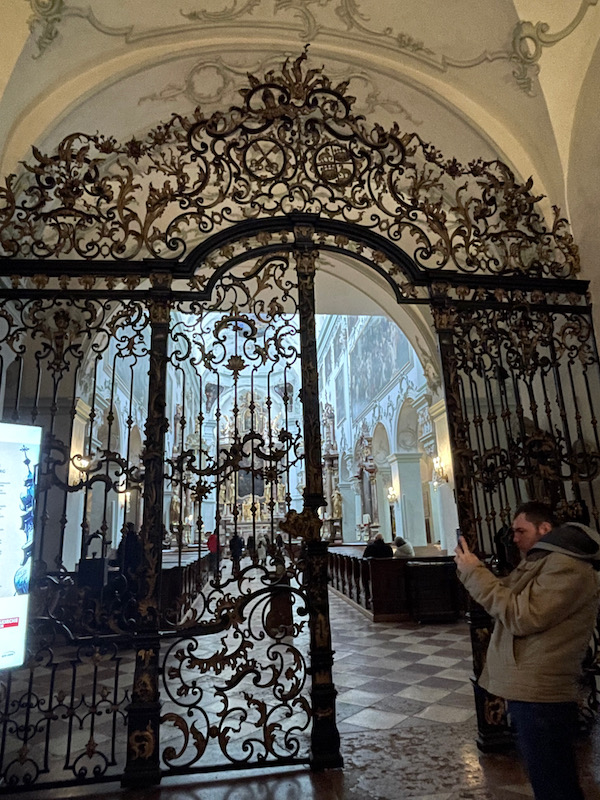
Now ... HERE is a church!!! Style-wise, it is Romanesque with the rounded arches down the sides of the nave. The vaulted ceiling is painted with frescoes surrounded by delicate Rococo stucco, created in 1764, which depict 4 scenes including this one, Handing over of keys to St. Peter
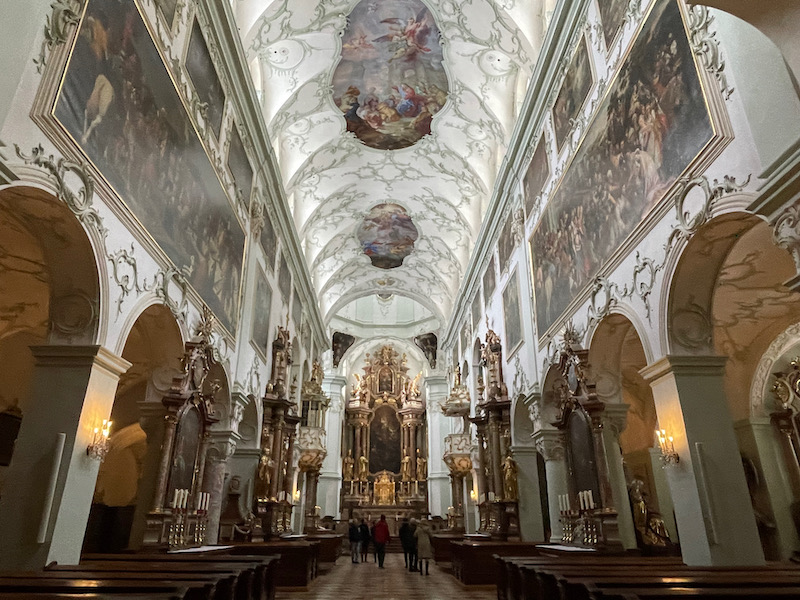
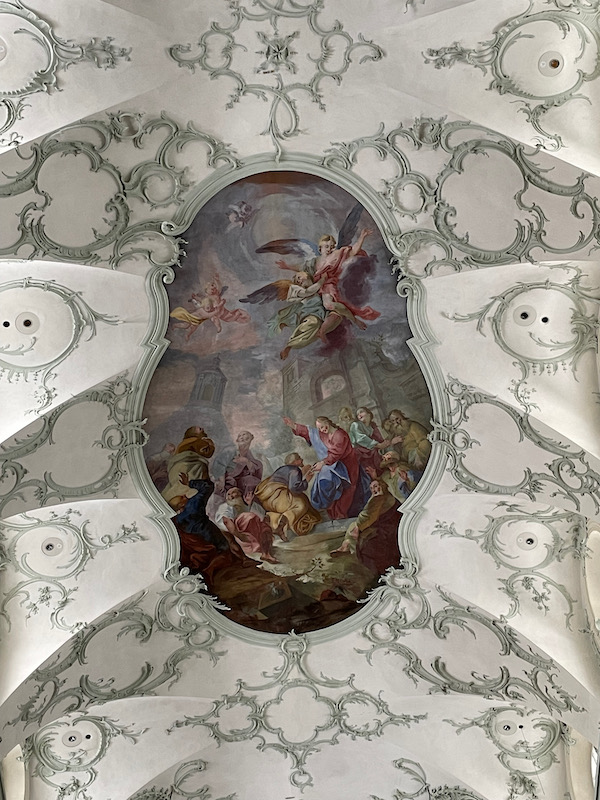
Here, the pulpit and oratory bay window in the nave are in the Baroque style, with the bay window enclosed with glass panes. Statues of Saint Paul and Saint Peter can be found on top.
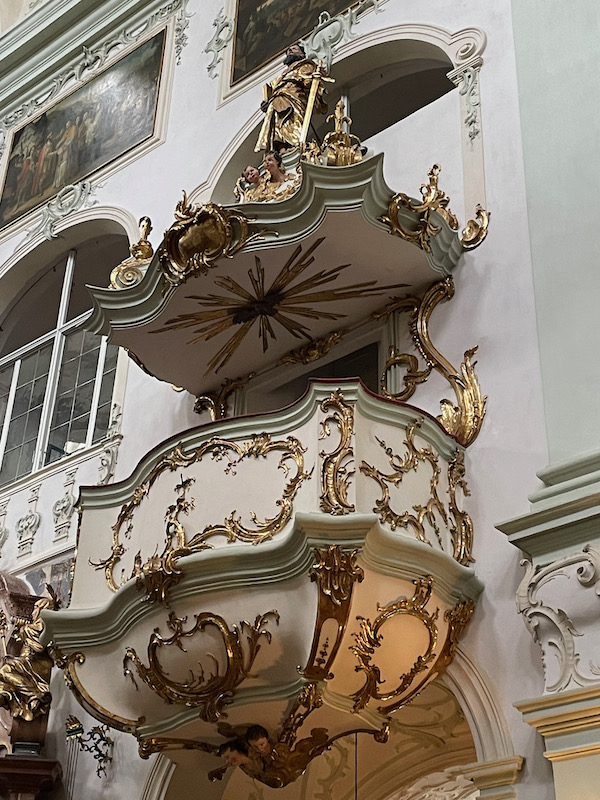
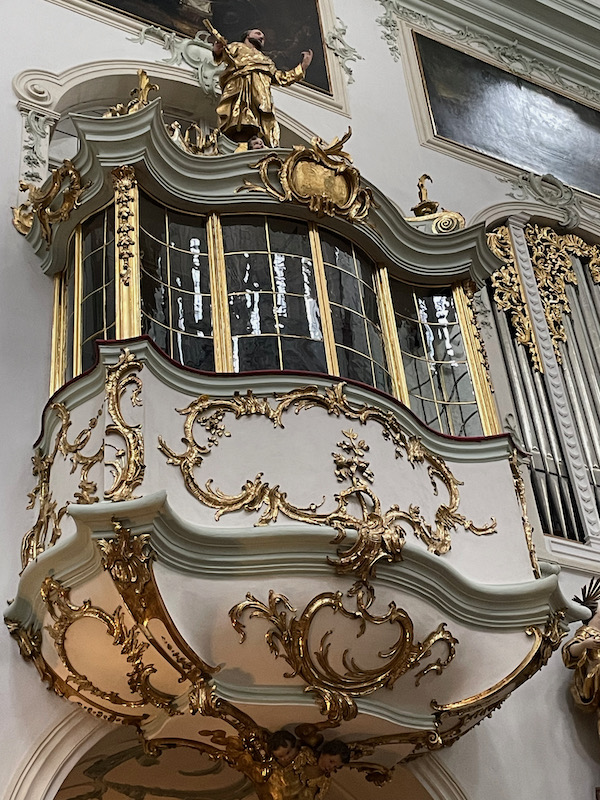
The main altar was built between 1777 and 1780. It has tall marble columns on either sides of a panting showing St. Peter, Saint Paul and Saint Benedict with surrounding angels venerating the Virgin and Child.
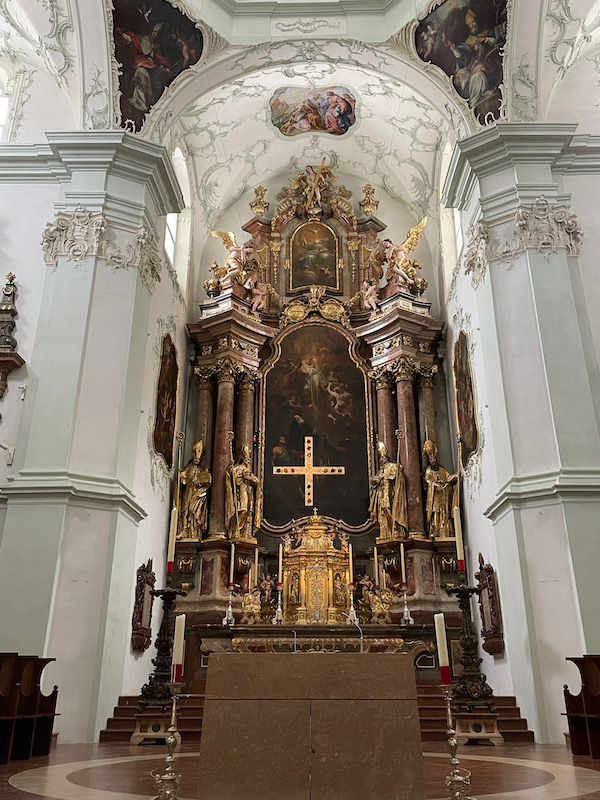
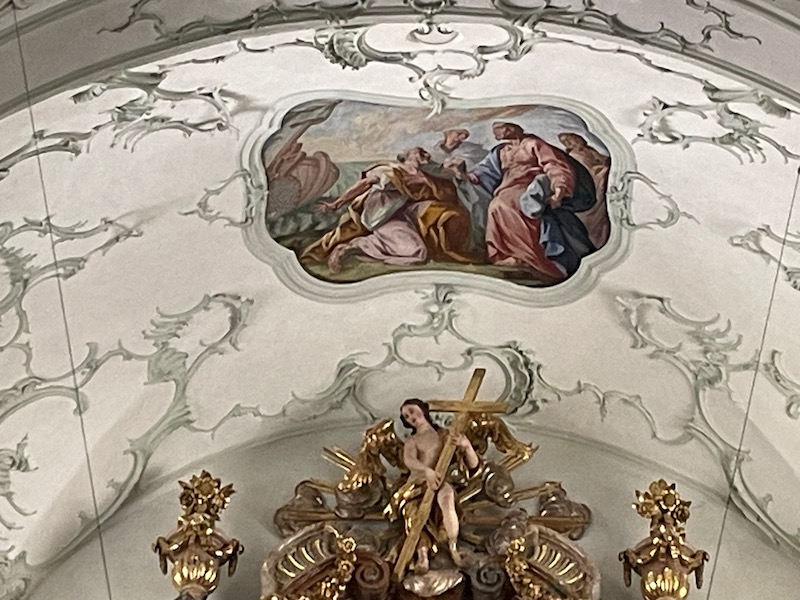
There are additional altars in the nave and the transept, all of them created in the 1770s although some of the paintings housed in the altarpieces date back to 1662-1704. One of them has a statue of the Virgin Mary that dates from 1420. All of them are very much Baroque in style.
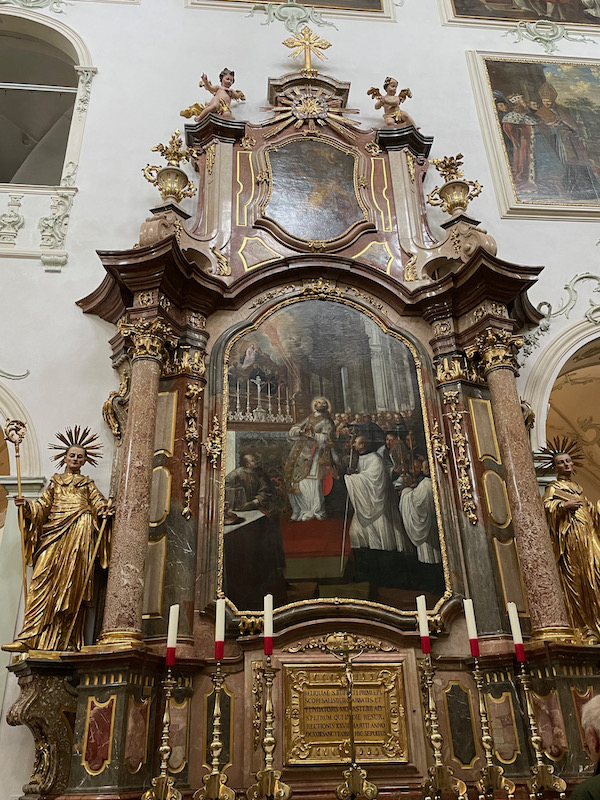
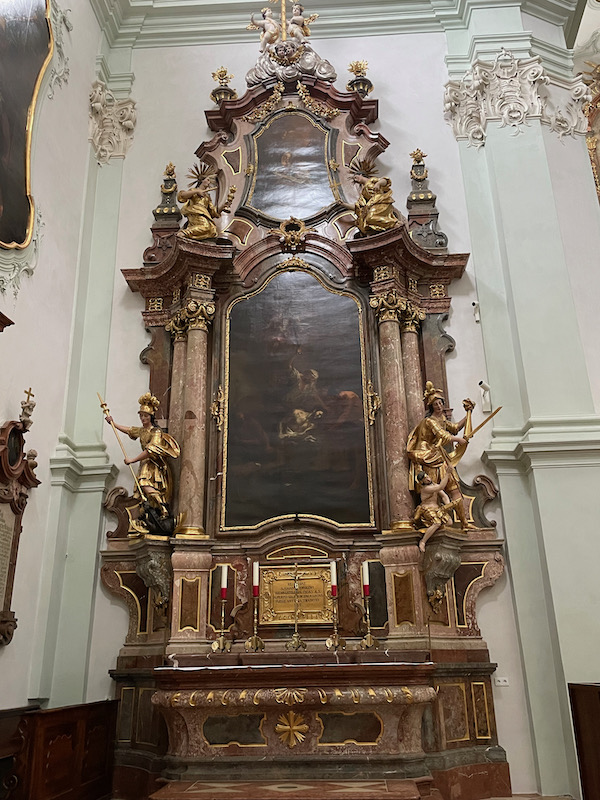
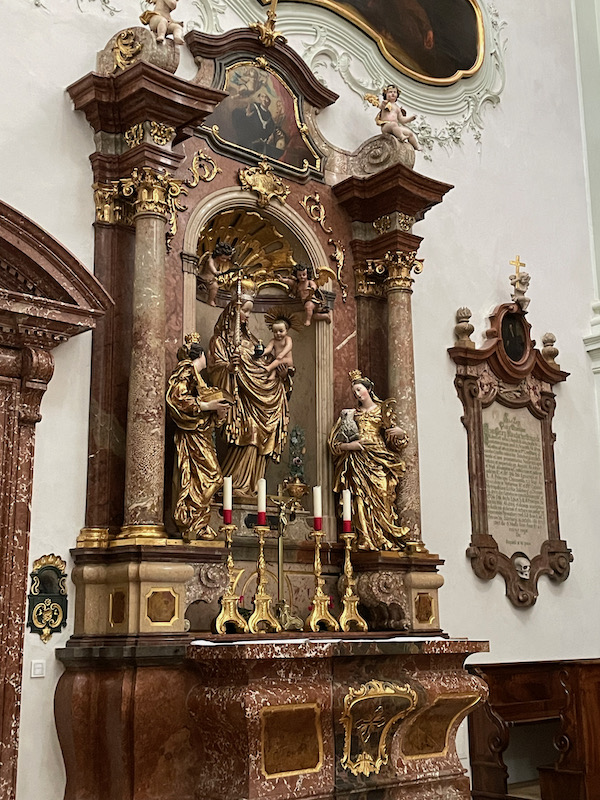
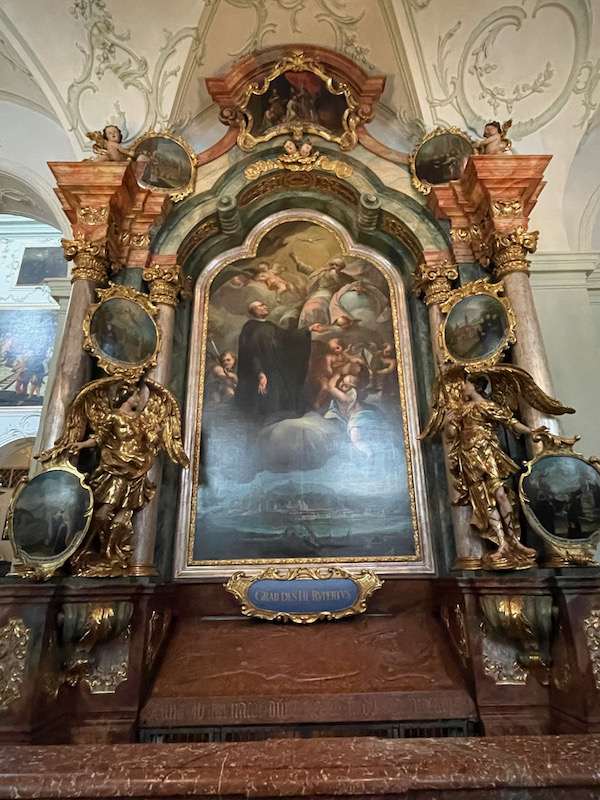
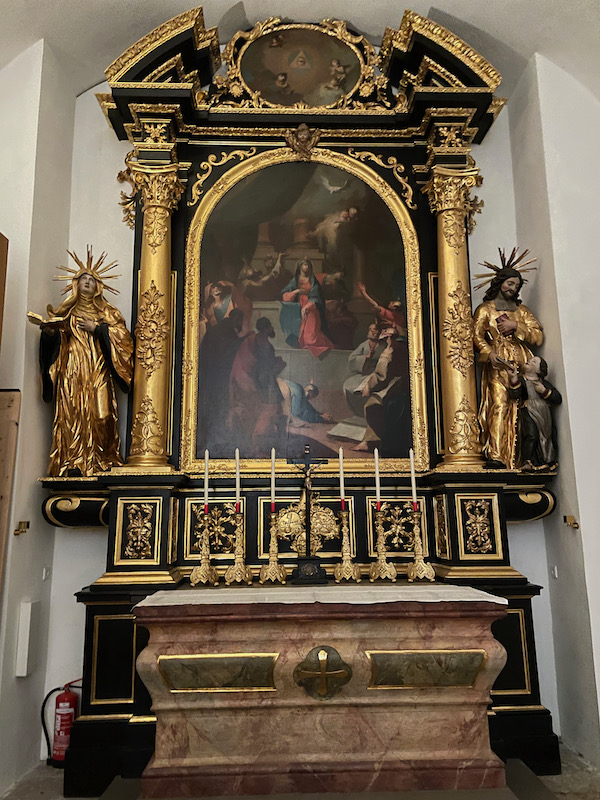
In 1885, remains of Romanesque and Gothic wall paintings from the 12th and 13th centuries were discovered and uncovered in the church.
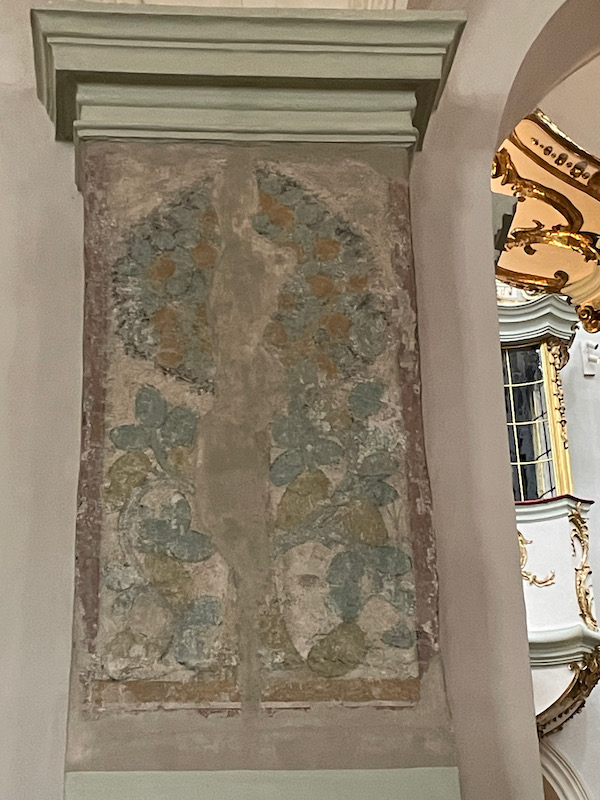
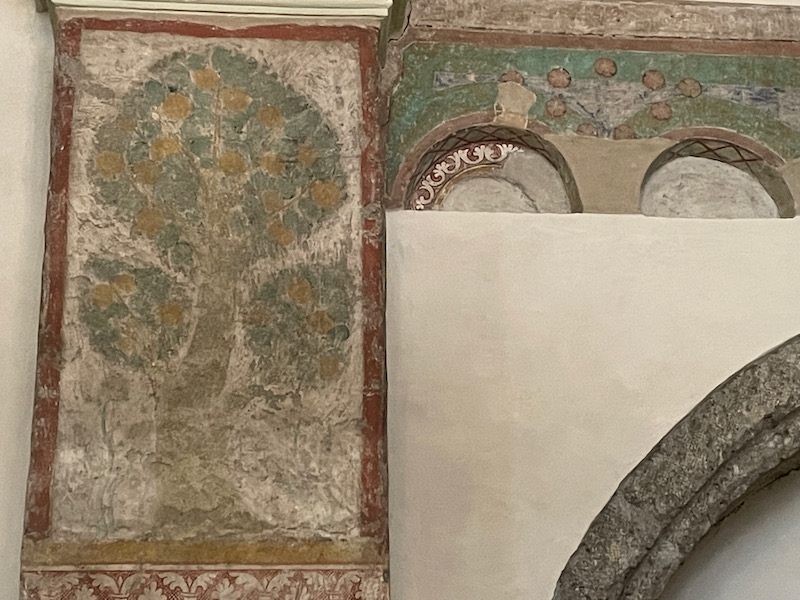
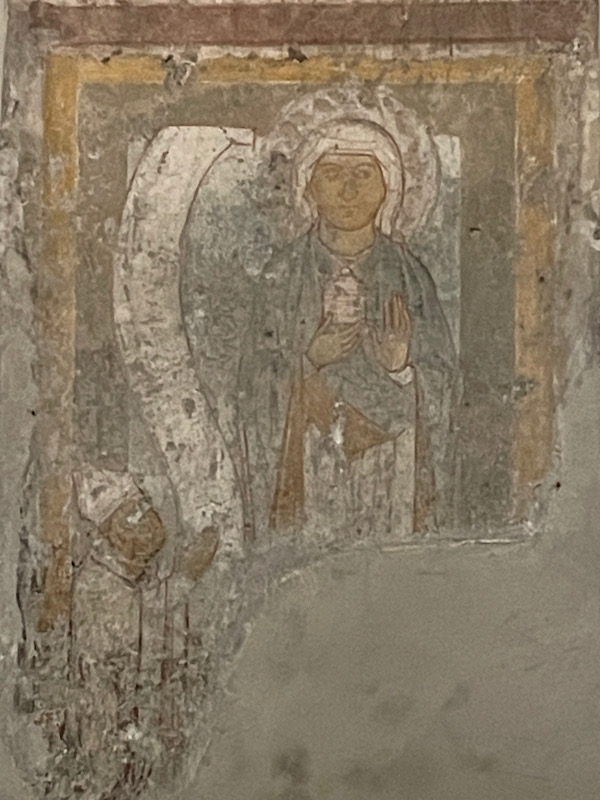
The Petersfriedhof (cemetery) was probably laid out during the foundation of the monastery about 700. The burial ground was first mentioned in 1139, with the oldest preserved graves from 1288 and 1300. It is centered around Late Gothic St Margaret's Chapel, which was dedicated about 1170 and refurbished in 1614. You can see the grave memorials lining the walls.
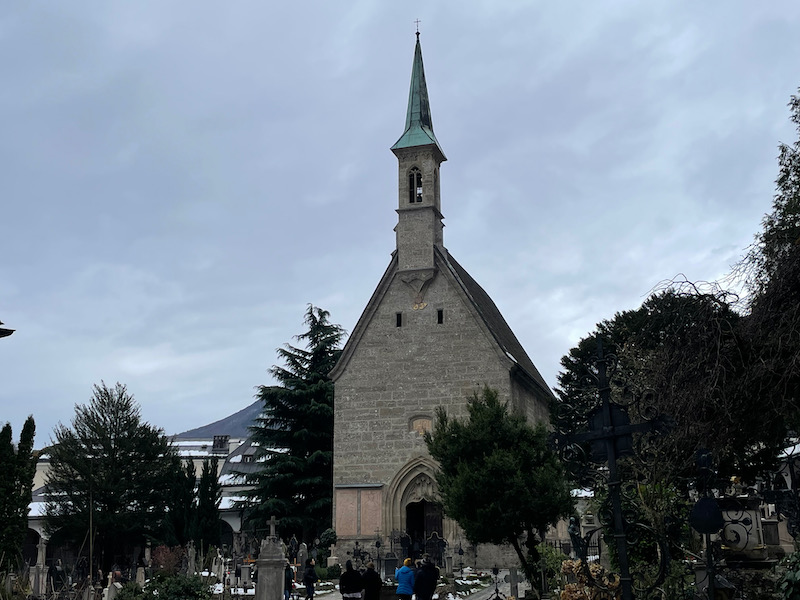
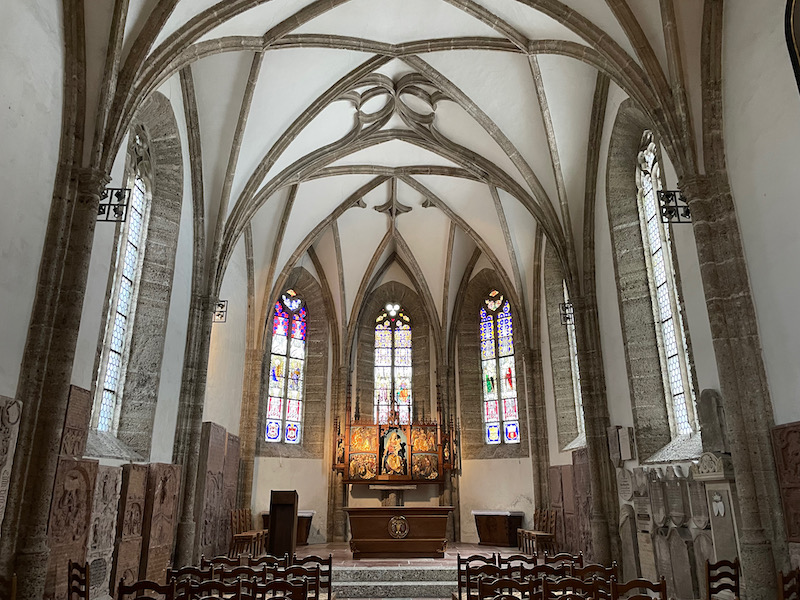
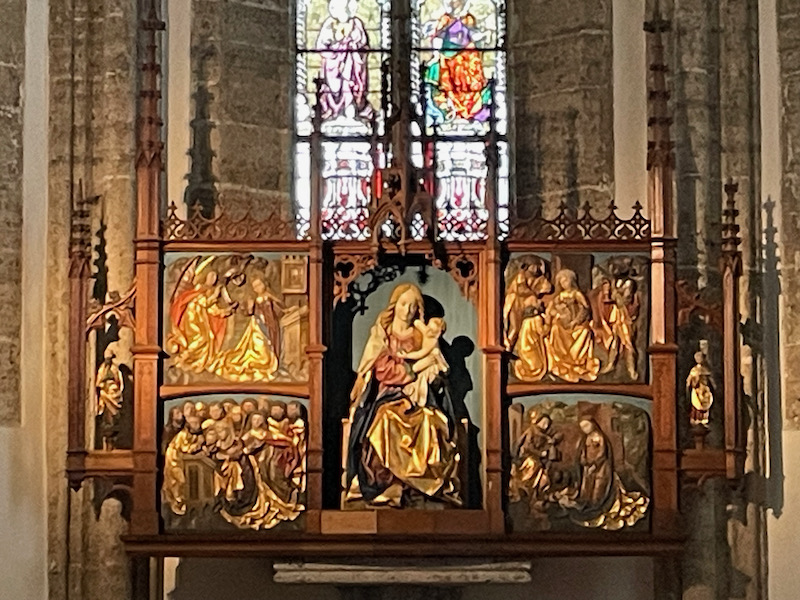
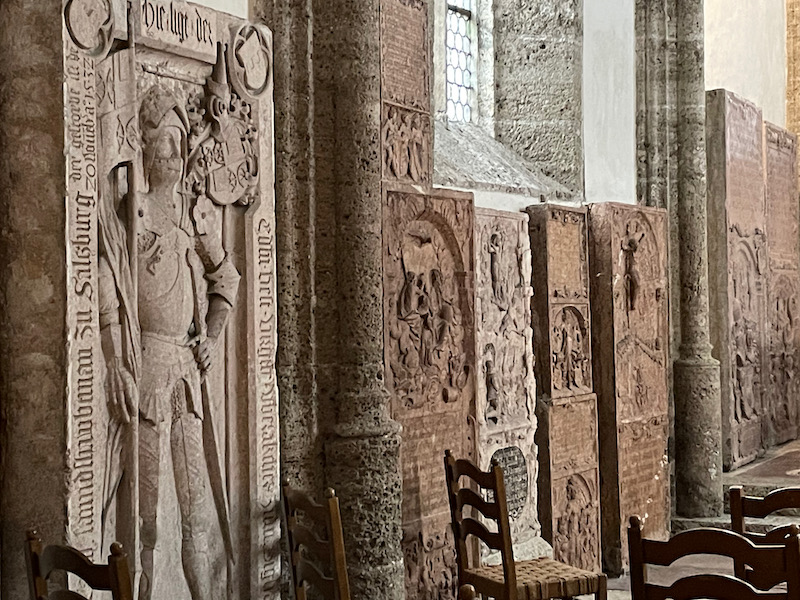
Several tombs are located in arcades built at the foot of the Festungsberg hill. The cemetery grounds are known for its catacombs carved out of the conglomerate rocks of the hill.
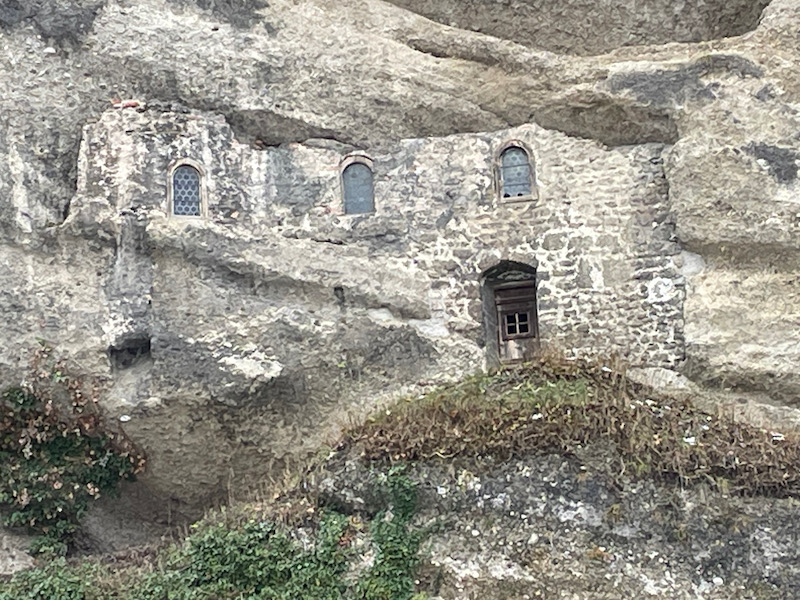
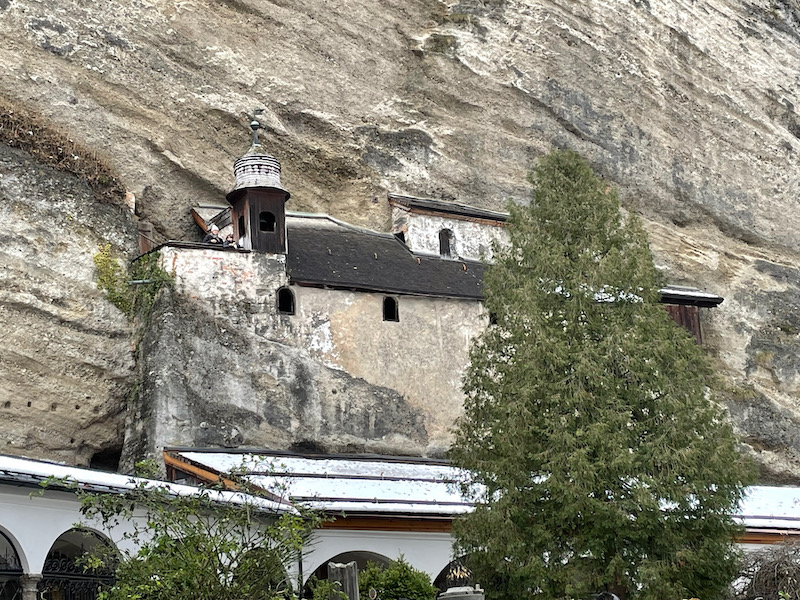
And finally ... the Wettersäule, or weather station. This is interesting in that it sits in a little courtyard area next to one of the main buildings in the Old Town. It was built in 1888 in a Neo-Renaissance style and records the daily temperature and daily atmospheric pressure.
